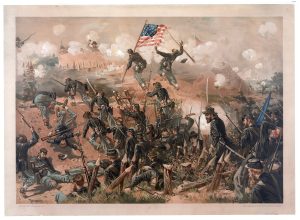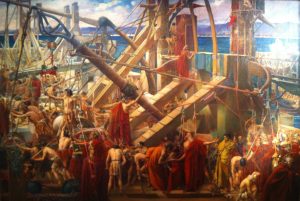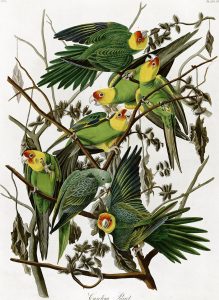Homes of Thomas Jefferson, James Madison, and James Monroe in Virginia
Thomas Jefferson, James Madison, and James Monroe, three of the early Presidents of the United States, were prominent political figures, neighbors, and friends in Virginia. Each had a significant estate that reflected their interests and lifestyles.
Thomas Jefferson: Monticello
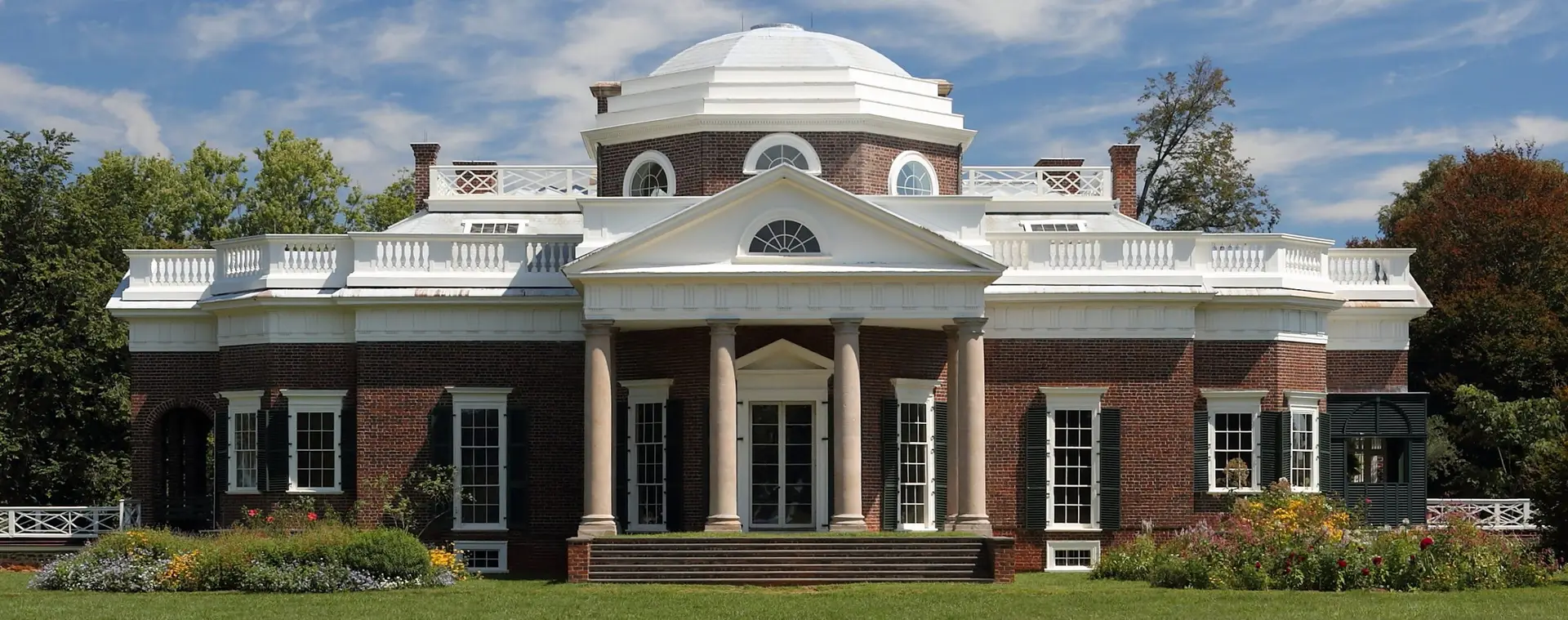
Monticello in September 2013 (Wiki Image).
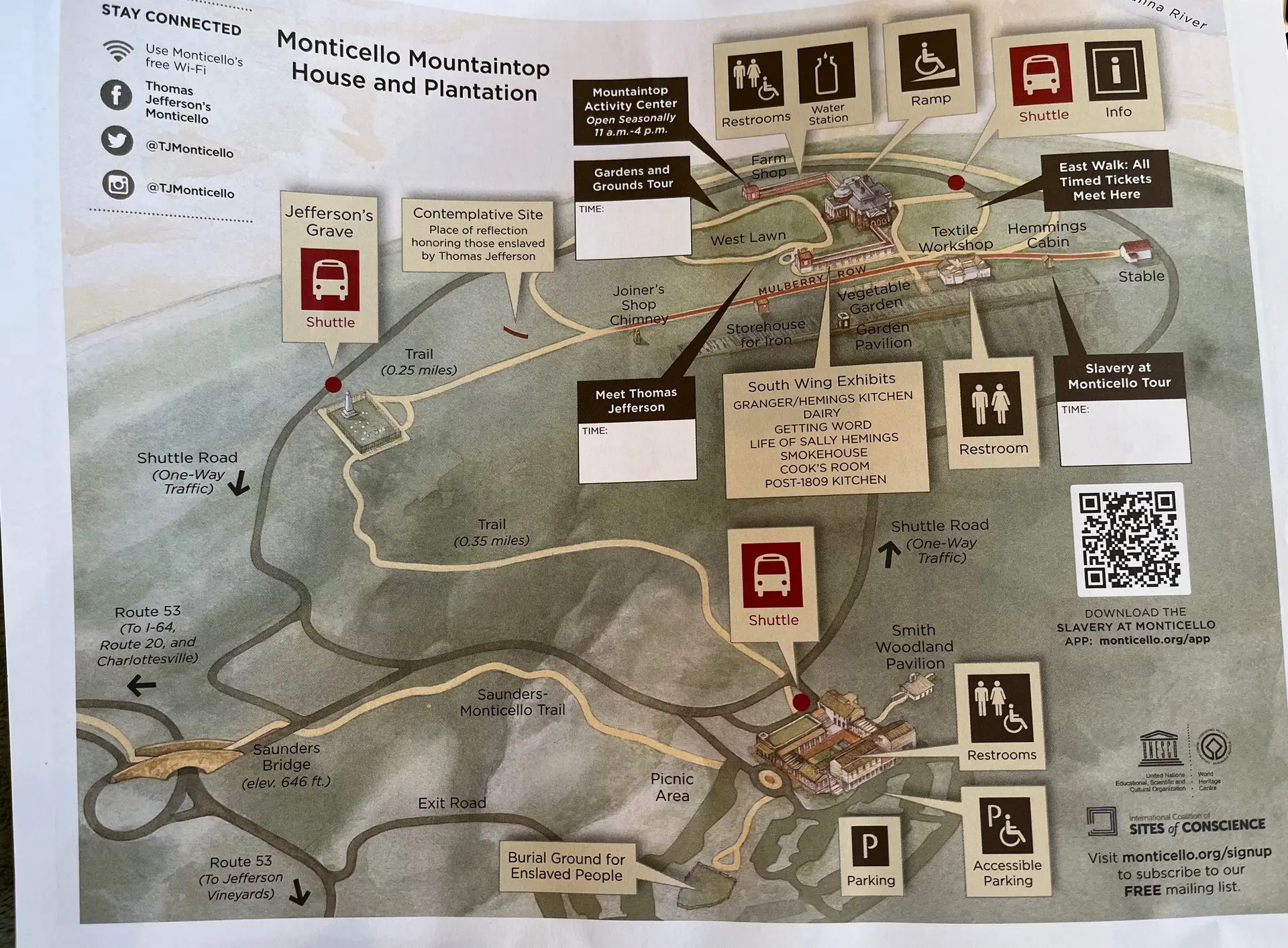 Monticello Location
Monticello Location
Location: Charlottesville, Virginia
Overview:
- Design and Architecture: Designed by Jefferson himself, Monticello is an architectural masterpiece that reflects his classical tastes and innovative spirit. It includes features such as a dome, skylights, and numerous inventions.
- Gardens and Grounds: Jefferson was a passionate horticulturist. Monticello’s grounds include extensive gardens, orchards, and vineyards. He experimented with a wide variety of plants and agricultural techniques.
- Legacy: Monticello is now a UNESCO World Heritage Site and museum preserved by the Thomas Jefferson Foundation. It offers tours and educational programs to explore Jefferson’s life and contributions to American history.
Notable Features:
- Main House: This house is characterized by its neoclassical design, dome, and Jefferson’s inventions, such as the revolving bookstand and dumbwaiter.
- Mulberry Row: The industrial hub of the plantation where enslaved people lived and worked.
James Madison: Montpelier
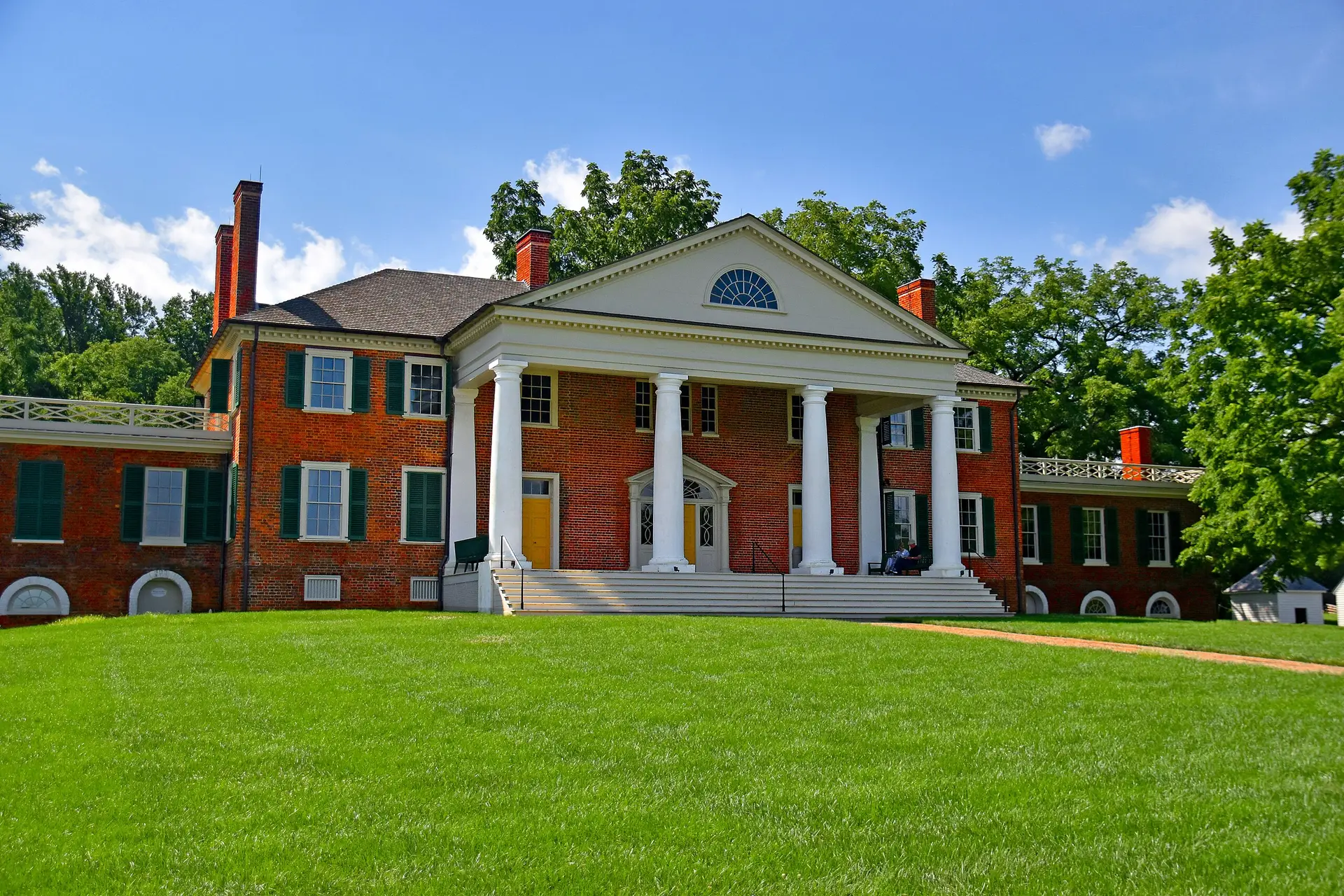
Montpelier (Wiki Image).
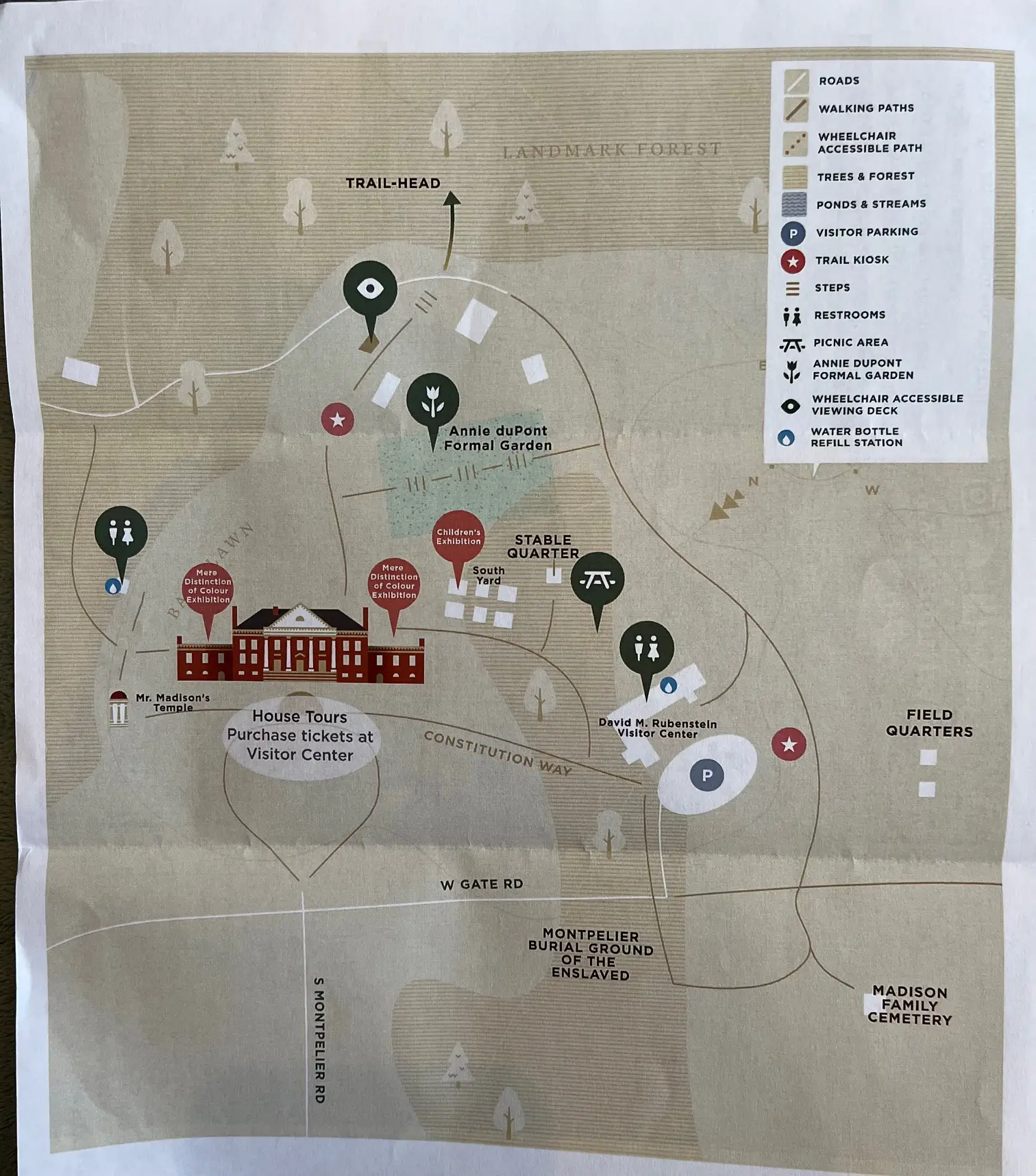 Montpelier Location
Montpelier Location
Location: Orange County, Virginia
Overview:
- Historical Significance: Montpelier was the lifelong home of James Madison, the “Father of the Constitution.” Madison and his wife, Dolley Madison, played significant roles in American history from this estate.
- Architecture: The mansion reflects Georgian and Federal architectural styles. Madison expanded the house to accommodate his growing family and political career.
- Restoration: The Montpelier Foundation has restored the estate to its early 19th-century appearance, providing a glimpse into Madison’s life and times.
Notable Features:
- Temple: A small, classical-style building that Madison used as a study.
- Garden: Madison designed the garden, which includes a variety of plants and reflects the period’s landscaping trends.
Legacy:
- Educational Center: Montpelier serves as a museum and educational center, offering programs about Madison’s contributions to the Constitution and American governance.
James Monroe: Highland
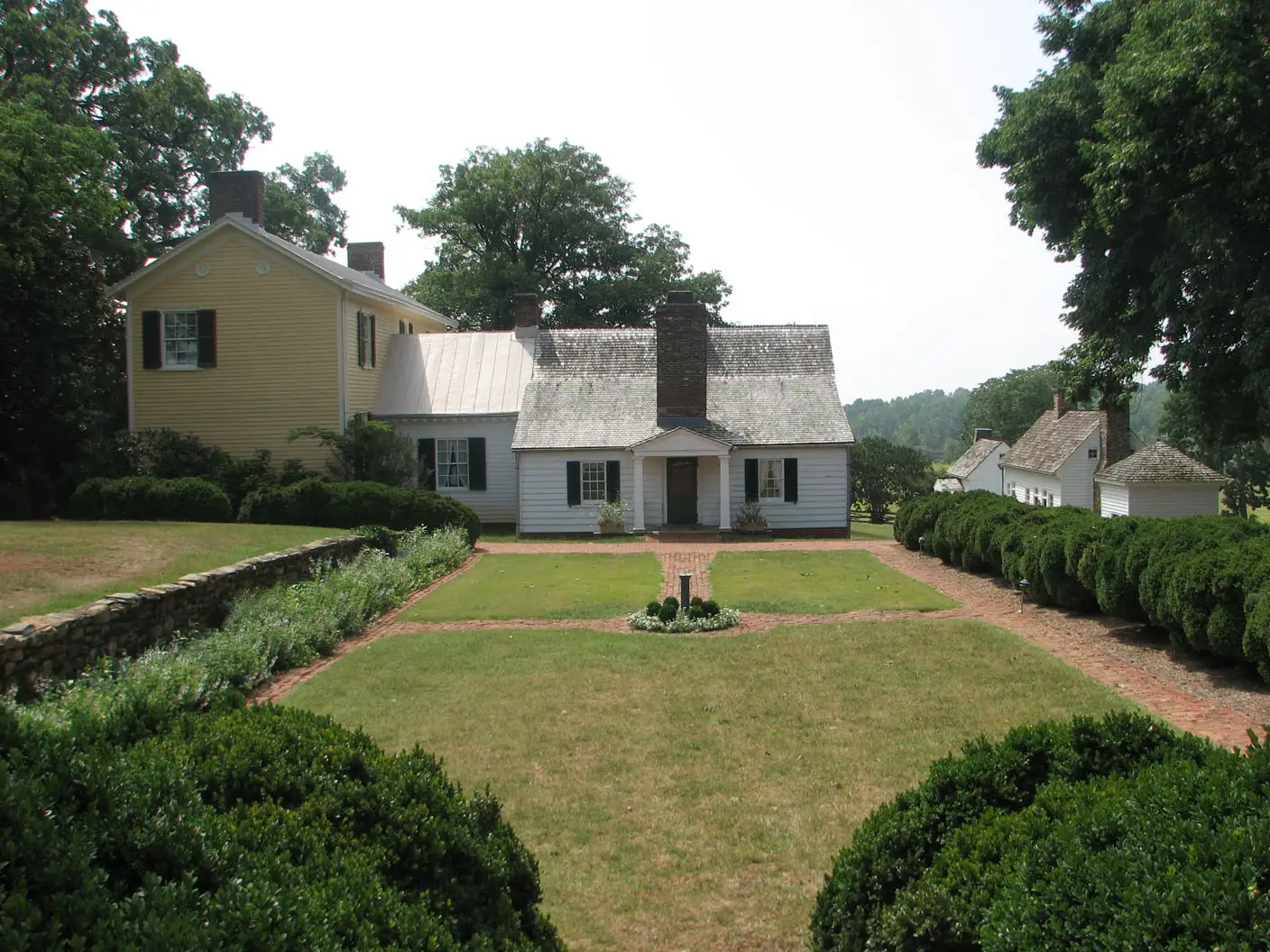
Highland, formerly Ash Lawn–Highland. Note: Later, owners added the yellow wing (Wiki Image).
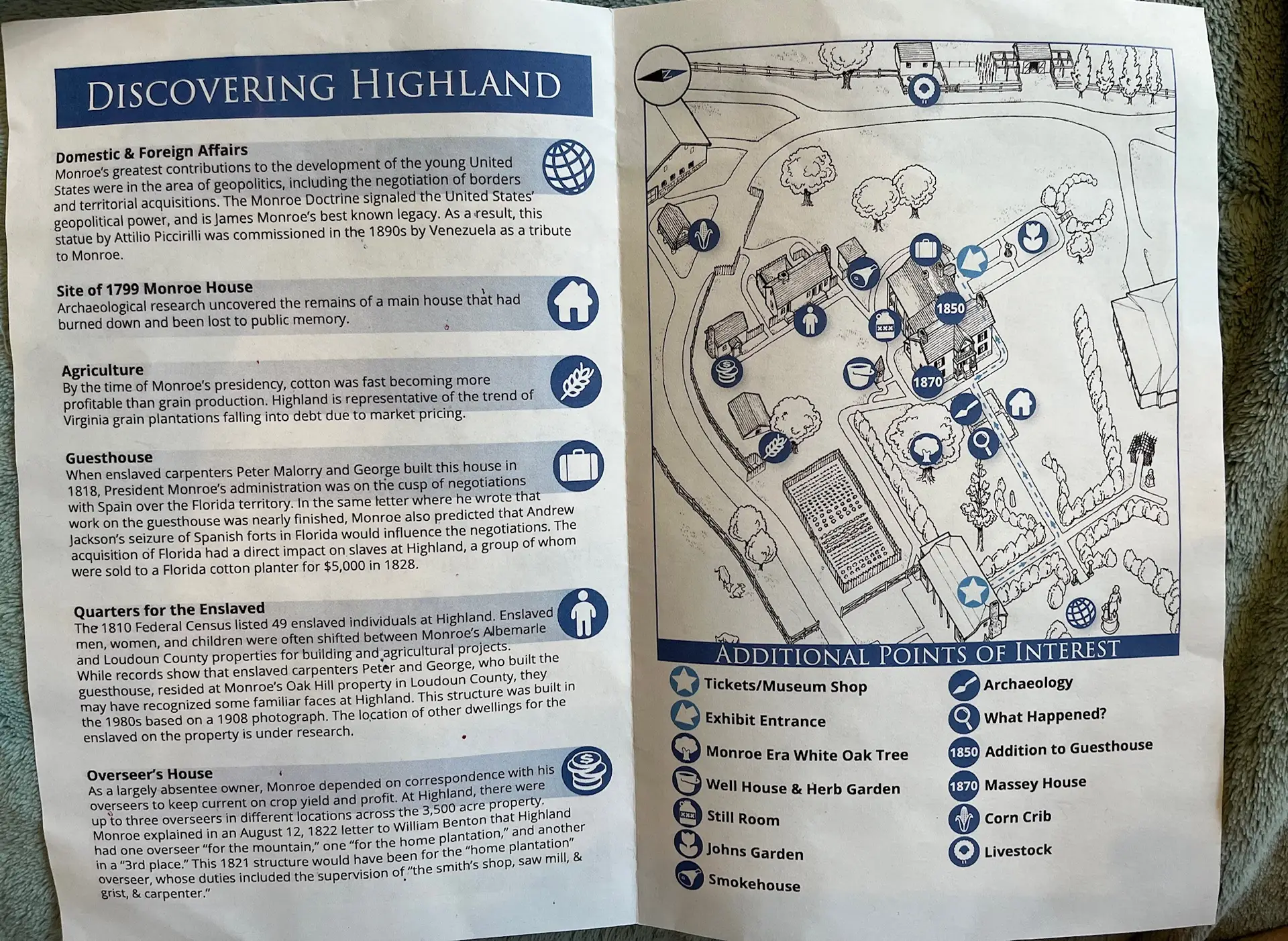
Highland Location
Location: Near Charlottesville, Virginia (called initially “Ash Lawn-Highland”)
Overview:
- Historical Significance: Highland was Monroe’s residence from 1799 until 1823. It served as his home during his tenure as Secretary of State, Secretary of War, and President.
- Architecture: The original house was modest compared to Monticello and Montpelier. Monroe expanded it over time, reflecting his increasing stature.
- Restoration and Research: Recent archaeological discoveries have shed new light on the original house and Monroe’s life there. The estate is being restored to reflect these findings.
Notable Features:
- Guest House: A small cottage where Monroe and his family lived while the main house was under construction.
- Gardens and Outbuildings: Includes gardens, slave quarters, and other outbuildings essential to the plantation’s operations.
Legacy:
- Historical Site: Highland is now a historic site and museum, offering tours highlighting Monroe’s life, presidency, and the broader context of early American history.
Conclusion
Thomas Jefferson, James Madison, and James Monroe left indelible marks on American history, not only through their political achievements but also through their Virginia estates. Monticello, Montpelier, and Highland each reflect these founding fathers’ interests, architectural tastes, and legacies. Today, these homes serve as museums and educational centers, preserving the history and contributions of Jefferson, Madison, and Monroe for future generations.
Additional Notes:
- Visiting: All three homes are open to the public as historic sites, offering fascinating glimpses into the lives and times of these Founding Fathers.
- Legacy of Slavery: It’s impossible to discuss these homes without acknowledging the role of enslaved people in building and maintaining them. All three sites grapple with the complexity of presenting this history alongside the stories of their famous owners.
Thomas Jefferson: Monticello
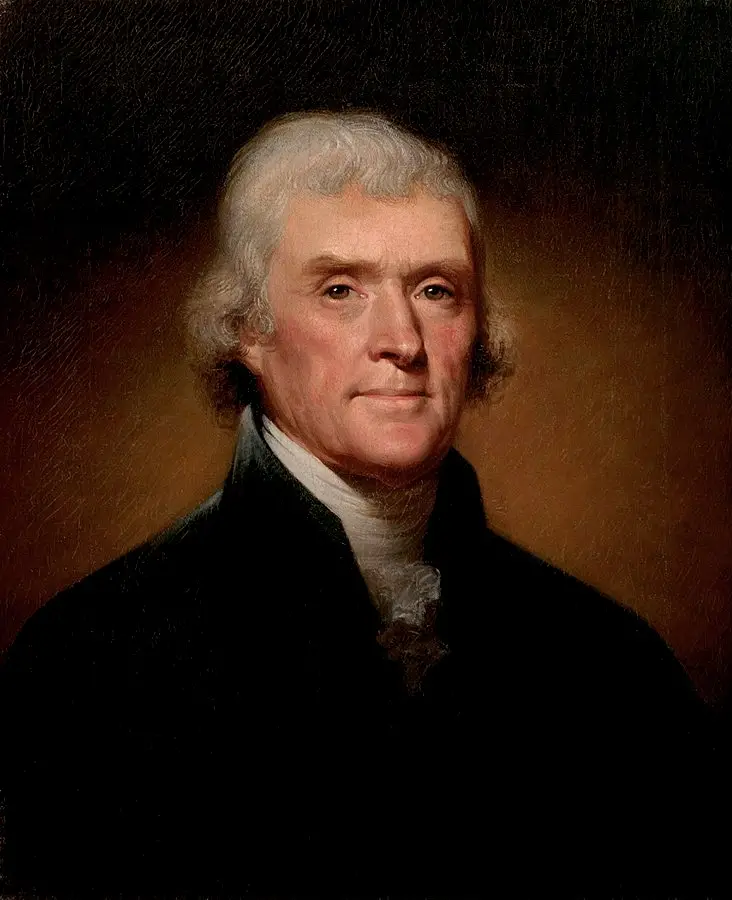
Thomas Jefferson (Wiki Image).
- Thomas Jefferson on Monticello:
- “I am as happy nowhere else and in no other society, and all my wishes end, where I hope my days will end, at Monticello.” — Thomas Jefferson
- Thomas Jefferson on Knowledge and Learning:
- “I cannot live without books.” — Thomas Jefferson, written in a letter to John Adams
- Thomas Jefferson on Agriculture:
- “Agriculture is our wisest pursuit, because it will in the end contribute most to real wealth, good morals, and happiness.” — Thomas Jefferson, in a letter to George Washington
- Thomas Jefferson on Slavery:
- “I tremble for my country when I reflect that God is just; that his justice cannot sleep forever.” — Thomas Jefferson, reflecting on slavery in his Notes on the State of Virginia
- Thomas Jefferson on Liberty and Government:
- “The tree of liberty must be refreshed from time to time with the blood of patriots and tyrants. It is its natural manure.” — Thomas Jefferson, in a letter to William Stephens Smith
- Thomas Jefferson on Architecture:
- “Architecture is my delight, and putting up, and pulling down, one of my favorite amusements.” — Thomas Jefferson, in a letter to Margaret Bayard Smith
- Thomas Jefferson on Monticello as a Retreat:
- “No occupation is so delightful to me as the culture of the earth, and no culture comparable to that of the garden.” — Thomas Jefferson
- Thomas Jefferson on Innovation:
- “I like the dreams of the future better than the history of the past.” — Thomas Jefferson
- Thomas Jefferson on Family and Home:
- “To myself, personally, the charm of Monticello is that of the most favored spot on earth. But, dear Sir, it is my home, and never was there a heart of more truly domestic cast.” — Thomas Jefferson
- Thomas Jefferson on Contradiction and Slavery:
- “We have the wolf by the ear, and we can neither hold him nor safely let him go. Justice is on one scale, and self-preservation is on the other.” — Thomas Jefferson, in a letter to John Holmes, referred to the Missouri Compromise and the institution of slavery.
| Year | Event/Development |
|---|---|
| 1735 | Peter Jefferson, Thomas Jefferson’s father, acquired the 5,000-acre tract of land that includes Monticello. |
| 1743 | Thomas Jefferson is born at Shadwell, his family’s plantation. |
| 1768 | Construction begins on the first version of Monticello, a one-story pavilion based on Palladian architecture. |
| 1770 | Jefferson moves into the South Pavilion at Monticello. |
| 1772 | Jefferson marries Martha Wayles Skelton. |
| 1770s | Jefferson continues to develop Monticello, adding dependencies and landscaping. |
| 1782 | Martha Jefferson dies. |
| 1784-1789 | Jefferson is in France as Minister to France. He sends architectural ideas and books back to Monticello. |
| 1794 | Construction begins on the remodeling and expansion of Monticello, incorporating elements of French architecture. |
| 1796-1801 | Jefferson served as vice president under President John Adams. |
| 1801-1809 | Jefferson served as the third President of the United States. When not in Washington, D.C., he spent time at Monticello. |
| 1809 | Jefferson retires from the presidency and returns to Monticello. |
| 1817 | Jefferson founds the University of Virginia. |
| 1826 | Thomas Jefferson dies at Monticello on July 4th, the 50th anniversary of the Declaration of Independence. |
| 1826 | Monticello is inherited by Jefferson’s daughter, Martha Jefferson Randolph. |
| 1831 | Martha Jefferson Randolph sells Monticello due to financial difficulties. |
| 1834 | Uriah P. Levy, a Jewish naval officer and admirer of Jefferson, purchases Monticello. |
| 1862 | The Confederate government seizes Monticello during the Civil War. |
| 1865 | Uriah P. Levy’s estate regains possession of Monticello after the Civil War. |
| 1923 | The Thomas Jefferson Foundation (now the Thomas Jefferson Foundation, Inc.) is founded to purchase and preserve Monticello. |
| 1926 | Monticello is officially opened to the public as a museum and historical site. |
| 1987 | Monticello is designated a UNESCO World Heritage site. |
| 1990s – Present | At Monticello, archaeological and historical research, restoration, and interpretation efforts continue, including the restoration of the Mulberry Row slave quarters and the exploration of the lives of the enslaved community. |
Thomas Jefferson’s Monticello
(YouTube video)
Behind the Scenes: Monticello’s 2nd and 3rd Floors
(YouTube video)
Thomas Jefferson, the third President of the United States, was not only a statesman and founding father but also an architect, scholar, and farmer. His home, Monticello, located in Virginia, is a testament to his diverse interests and enduring legacy.
Monticello: Jefferson’s Beloved Home
Design and Architecture
- Architectural Influence: Jefferson designed Monticello, drawing inspiration from classical architecture and incorporating elements from his European travels. The neoclassical design reflects Jefferson’s admiration for ancient Roman and Renaissance styles.
- Construction: Monticello’s construction spanned several decades. Jefferson began building it in 1768 and continued to remodel and expand it until he died in 1826. The estate is on a hilltop, providing a panoramic view of the surrounding Virginia countryside.
Features
- Main House: The main house of Monticello features a dome, an unusual architectural element for the time. It includes numerous innovations, such as a revolving bookstand, a dumbwaiter for wine, and skylights to enhance natural lighting.
- Gardens and Grounds: Jefferson’s passion for horticulture is evident in the extensive gardens surrounding Monticello. He cultivated various plants, including vegetables, fruits, and ornamental flowers. The estate also featured vineyards and orchards.
- Dependency Structures: Monticello included numerous outbuildings such as a smokehouse, icehouse, and stables. Jefferson’s meticulous attention to detail extended to these structures, ensuring their functionality and aesthetic harmony with the main house.
Life at Monticello
Personal Retreat
- Scholar’s Haven: Monticello served as Jefferson’s retreat, where he indulged in his scholarly pursuits. He amassed a vast library, wrote extensively, and conducted scientific experiments.
- Family Home: Monticello was also Jefferson’s family home, where he lived with his daughters and extended family. The estate was a hub of activity, with numerous visitors, including prominent political and intellectual figures.
Agricultural Enterprise
- Farming Practices: Jefferson was deeply involved in the agricultural operations at Monticello. He experimented with various crops and farming techniques to improve agricultural productivity and sustainability.
- Slave Labor: The labor force at Monticello consisted primarily of enslaved people. Jefferson owned over 600 slaves during his lifetime, who worked in the fields, maintained the house, and supported the estate’s various enterprises. This aspect of Jefferson’s legacy is complex and controversial, reflecting the contradictions between his advocacy for liberty and his reliance on enslaved labor.
Legacy of Monticello
Historic Preservation
- Monticello Today: Monticello is now a UNESCO World Heritage Site and a museum, open to the public for tours and educational programs. The Thomas Jefferson Foundation maintains the estate to preserve Jefferson’s legacy and promote an understanding of his contributions to American history.
- Educational Initiatives: The foundation offers various educational programs, including lectures, workshops, and exhibitions, to explore Jefferson’s life, ideas, and the broader context of American history.
Symbol of Jeffersonian Ideals
- Architectural Innovation: Monticello symbolizes Jefferson’s innovative spirit and contributions to American architecture. The house and its design elements continue to inspire architects and historians.
- Reflection of Contradictions: Monticello also embodies the contradictions of Jefferson’s life—his advocacy for democracy and individual rights alongside his ownership of enslaved people. This duality prompts discussions about American history’s complexities and its founding figures’ legacies.
Conclusion
Thomas Jefferson’s home in Virginia, Monticello, is a lasting monument to his multifaceted legacy. As an architect, Jefferson created a home that blended classical beauty with practical innovation. As a scholar and farmer, he cultivated a retreat that nurtured his intellectual and agricultural pursuits. However, Monticello also serves as a reminder of the contradictions in Jefferson’s life, particularly regarding slavery. Today, Monticello stands as both a historic site and a symbol, inviting reflection on the enduring complexities of Jefferson’s contributions to American history.
Monticello
Thomas Jefferson Monticello Architectural Influence and Construction.
Thomas Jefferson’s Monticello, his plantation home in Virginia, is a masterpiece of architecture that reflects his deep interest in design, classical ideals, and innovative construction techniques. Monticello stands as a symbol of Jefferson’s vision for America, blending European influences with American practicality.
Architectural Influence:
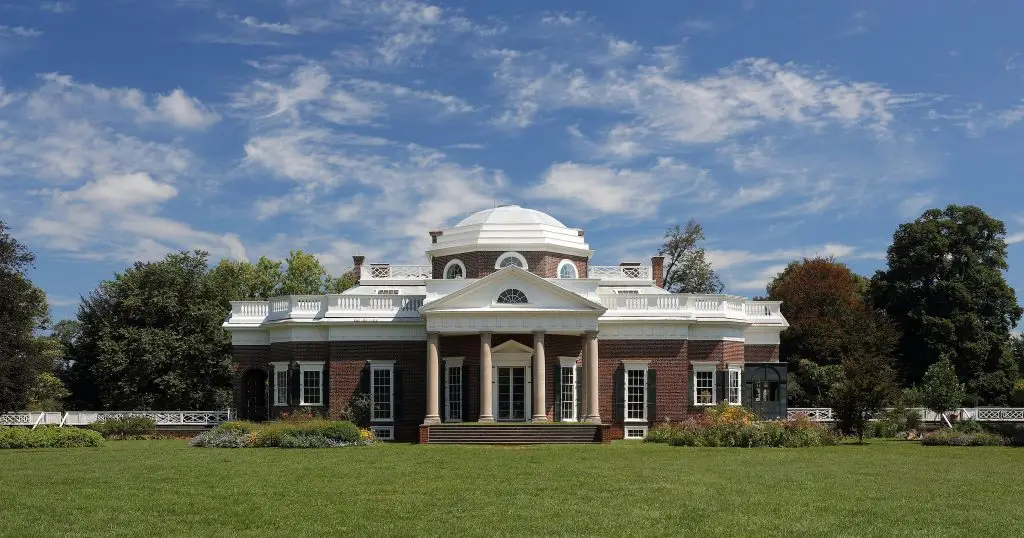
Palladian Style: Thomas Jefferson’s “second” Monticello (1772) (Wiki Image).
- Classical Inspiration:
- Jefferson was heavily influenced by classical architecture, particularly the works of the Italian Renaissance architect Andrea Palladio. Palladio’s treatises on architecture, which emphasized symmetry, proportion, and the use of classical elements such as columns, pediments, and domes, inspired Jefferson’s design for Monticello.
- The design also drew on Roman architecture, reflecting Jefferson’s admiration for the ancient Roman Republic, which he saw as a model for the new American republic. Using a domed roof, porticoes, and columns directly reflects classical architecture.
- Palladian Style:
- Jefferson adapted the Palladian style to the American context. Monticello features a balanced and harmonious layout, with a central dome and symmetrical wings. The emphasis on geometric shapes and classical forms made Monticello a pioneering example of Palladian architecture in the United States.
- The house also reflects Enlightenment ideals, emphasizing reason, order, and the pursuit of knowledge, which Jefferson held dear. Monticello’s design was intended to be aesthetically pleasing and functional, reflecting the Enlightenment belief in the power of human reason to improve the world.
- European Grand Tour Influence:
- Jefferson’s time in Europe as the U.S. Minister to France (1785-1789) profoundly influenced his architectural tastes. During his stay in Paris, Jefferson studied French Neoclassical architecture, which emphasized grandeur and classical forms. This influence is evident in the second version of Monticello, which Jefferson remodeled after his return from France.
- He incorporated elements he had seen in European buildings, such as the Hôtel de Salm in Paris, into Monticello’s design. These influences are evident in the refined detailing, the use of large windows to bring in natural light, and the integration of the house with the surrounding landscape.
Construction of Monticello:
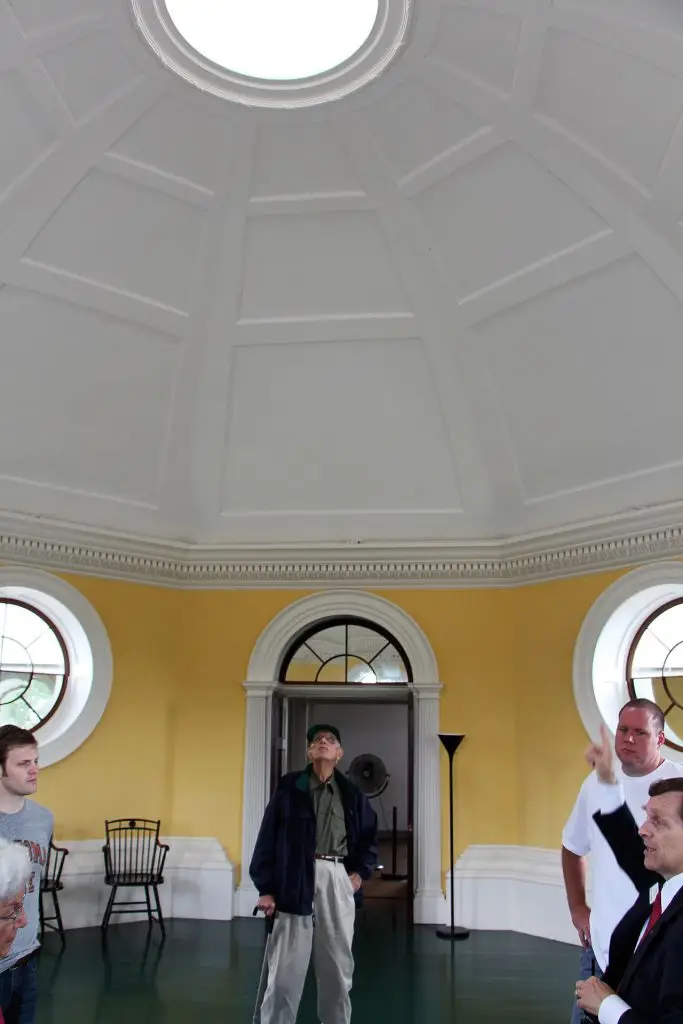
Under the dome (Wiki Image).
- Two Phases of Construction:
- First Phase (1769-1784): Jefferson began constructing Monticello in 1769, based on designs he had developed earlier. The original house was a two-story, eight-room building with a Palladian-style central hall and flanking wings. This first version of Monticello was relatively modest compared to the later design.
- Second Phase (1796-1809): After returning from France, Jefferson embarked on a significant remodeling of Monticello, transforming it into the iconic structure we know today. He replaced the original design with a more elaborate and refined version, adding the famous octagonal dome, expanding the house, and incorporating many classical elements and innovations he admired in Europe.
- Innovative Design Features:
- Jefferson integrated several innovative features into Monticello’s design. The house includes a sophisticated system of hidden corridors and dumbwaiters to provide efficient service without disturbing the main living areas. A dumbwaiter connected the kitchen, located in the basement, to the dining room, allowing food to be served quickly and discreetly.
- Jefferson also designed a unique system of skylights and large windows to maximize natural light within the house. The dome, one of Monticello’s most distinctive features, serves an aesthetic purpose and helps ventilate the upper floors.
- Integration with the Landscape:
- Monticello is carefully integrated into the surrounding landscape, reflecting Jefferson’s belief in the importance of harmony between architecture and nature. The house is on a hilltop, providing sweeping views of the Virginia countryside. Jefferson designed the gardens and grounds to complement the house, with terraced gardens, orchards, and walkways that blend seamlessly with the natural environment.
- Local materials, such as brick made from clay on the estate, reflect Jefferson’s commitment to using indigenous resources and his belief in self-sufficiency.
- Labor and Construction:
- Monticello was constructed largely by enslaved laborers who lived on the plantation. Skilled enslaved artisans, including blacksmiths, carpenters, and brickmakers, were integral to its construction. Jefferson, who owned over 600 slaves during his lifetime, relied on their labor not only for the construction of the house but also for its maintenance and operation.
- The contradiction between Jefferson’s advocacy for liberty and his dependence on enslaved labor is one of the most significant aspects of Monticello’s history, reflecting the broader contradictions of American society at the time.
Conclusion:
Monticello is more than just a house; it reflects Thomas Jefferson’s architectural vision, intellectual pursuits, and complex legacy. Influenced by classical ideals and European architecture, Jefferson created a uniquely American interpretation of these styles, integrating them with the landscape and incorporating innovative design features. However, Monticello also serves as a reminder of the contradictions inherent in Jefferson’s life, particularly his reliance on enslaved labor. Today, Monticello symbolizes Jefferson’s contributions to American architecture and the complexities of the nation’s founding principles.
Thomas Jefferson Monticello Main House, Gardens and Grounds, and Dependency Structures.
Monticello, Thomas Jefferson’s plantation estate near Charlottesville, Virginia, is renowned for its architectural beauty, meticulously designed gardens and grounds, and functional dependency structures supporting its daily operations. Each component reflects Jefferson’s Enlightenment ideals, his passion for innovation, and the complexities of life in early America.
Monticello’s Main House:
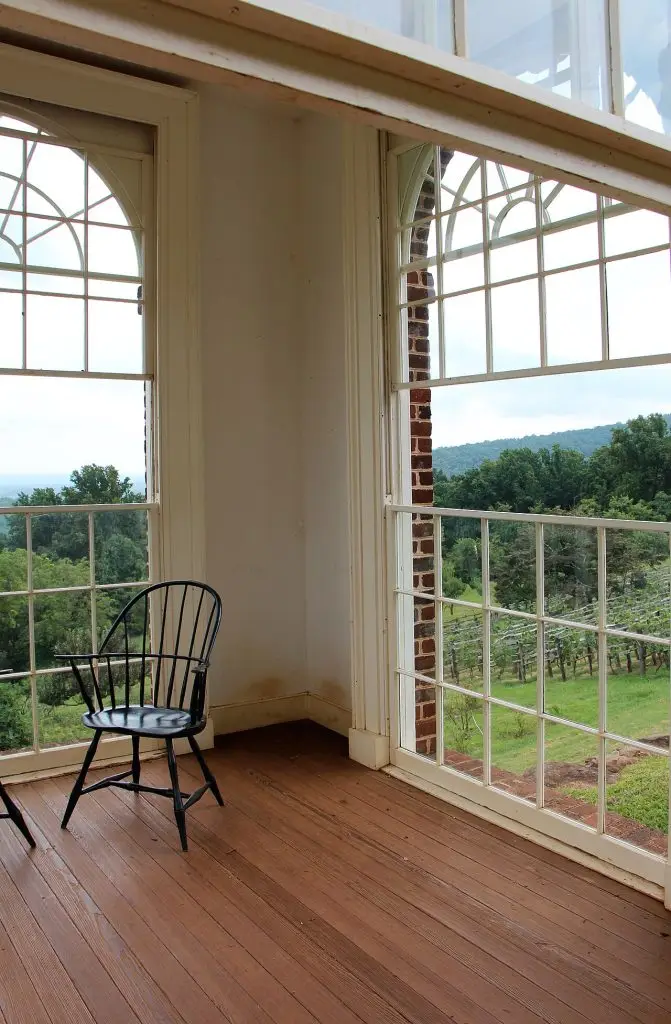
Inside the Pavilion at the Vegetable Garden (Wiki Image).
- Architectural Design:
- Classical Influence: The main house at Monticello is a prime example of Palladian architecture, reflecting Jefferson’s admiration for classical forms. The house is characterized by its symmetry, proportion, and use of classical elements like columns, pediments, and the iconic octagonal dome. The central dome, which crowns the house, is a defining feature and a bold architectural statement for its time.
- Layout and Functionality: The main house is designed around a central hall, with flanking rooms organized symmetrically. Jefferson’s design maximized functionality and aesthetic appeal, incorporating features like alcove beds, which saved space in bedrooms, and skylights, which brought natural light into the interior.
- Innovative Features: Jefferson’s main house was equipped with several innovative features. For example, he installed dumbwaiters to transport wine from the cellar to the dining room and created hidden staircases and passageways to let servants move about discreetly. The house also included a unique clock that displayed the time on both the interior and exterior of the building.
- Interior Spaces:
- Entrance Hall: The entrance hall serves as both a grand reception area and a museum. It displays items like Native American artifacts, maps, and European art, reflecting Jefferson’s interests and intellectual pursuits.
- Parlor: The parlor was the social center of the house, where guests were entertained. It features classical details, fine furniture, and portraits of historical figures, showcasing Jefferson’s taste and reverence for history.
- Library: Jefferson’s library was one of the most important rooms in the house, reflecting his lifelong commitment to learning. It housed thousands of books on various subjects, many of which later became part of the Library of Congress after Jefferson sold his collection to replace the one lost during the War of 1812.
- Dining Room: The dining room was for meals and intellectual discussions. Jefferson’s love of fine food and wine is evident in the room’s design, which included a rotating serving door and the aforementioned dumbwaiters to ensure efficient and elegant service.
Gardens and Grounds:
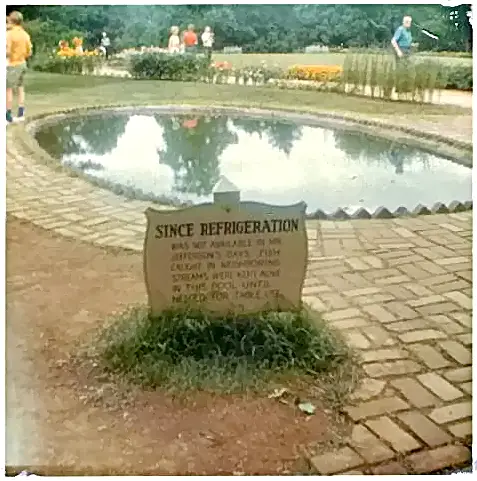
Before refrigeration, Jefferson had the pond stocked with fish to be available on demand (Wiki Image).
- Design and Layout:
- Terraced Gardens: Monticello’s gardens are a testament to Jefferson’s love of horticulture and his belief in the harmony between nature and architecture. The gardens were terraced into the hillside, creating flat, cultivated spaces for growing vegetables, fruits, and ornamental plants. These terraces maximized agricultural productivity and enhanced the estate’s aesthetic appeal.
- Vegetable Garden: Jefferson’s 1,000-foot-long vegetable garden was a laboratory where he experimented with various crops. He meticulously documented his successes and failures in his “Garden Book,” contributing to the development of American agriculture. The garden was organized into rows of different vegetables, herbs, and experimental plants, demonstrating Jefferson’s scientific approach to gardening.
- Orchards and Vineyards: The estate included orchards filled with fruit trees such as apples, peaches, and cherries and vineyards for growing grapes. Jefferson’s interest in viticulture led him to plant several varieties of grapes. However, his attempts to produce wine at Monticello were only partially successful due to the challenges posed by the Virginia climate.
- Ornamental Landscape:
- Flower Gardens: Jefferson’s flower gardens were designed to showcase a variety of native and exotic plants. He carefully arranged the flowers to bloom in succession, ensuring the garden would be colorful throughout the growing season. The gardens reflected Jefferson’s belief in the importance of beauty in everyday life and his appreciation for nature.
- Lawn and Grove: The lawn in front of Monticello, known as the “West Lawn,” was designed to provide an expansive view of the surrounding landscape. Jefferson also designed a grove of trees, which created a naturalistic setting around the house. The lawn and grove exemplify the English landscape garden style Jefferson admired for emphasizing natural beauty.
- Reflecting Jefferson’s Vision:
- The overall design of Monticello’s gardens and grounds reflects Jefferson’s vision of a self-sufficient, agrarian society. He believed that the land was the foundation of American democracy and that a well-designed, productive estate was a model for the nation. The gardens and grounds were functional and expressed Jefferson’s ideals of order, beauty, and harmony with nature.
Dependency Structures:
- Support Structures:
- South Pavilion: The South Pavilion was one of the first structures built at Monticello and served as Jefferson’s living quarters during the early years of the estate’s construction. It later became part of the complex of dependency buildings that supported the main house.
- Kitchen and Smokehouse: The main house’s basement kitchen was connected to the dining room by dumbwaiters and a passageway to ensure efficient meal preparation and service. The nearby smokehouse was used for preserving meat, an essential part of the estate’s food supply.
- Workshops and Storage:
- Blacksmith Shop and Joinery: Monticello included workshops for skilled craftsmen, including blacksmiths, joiners, and carpenters. These shops produced tools, furniture, and other items needed for the estate. The craftsmanship of the enslaved workers who operated these shops is evident in the fine architectural details found throughout Monticello.
- Ice House: Jefferson built an ice house on the property to store ice harvested from nearby rivers during the winter. The ice was used to preserve food and make ice cream, a delicacy Jefferson enjoyed and even introduced to the United States.
- Enslaved Quarters:
- Mulberry Row: Mulberry Row was a crucial part of Monticello’s dependency structures, serving as the center of activity for the enslaved community that lived and worked on the estate. The row included workshops, dwellings, and storage buildings, where much of the plantation’s day-to-day work was carried out.
- Living Conditions: The enslaved individuals who lived on Mulberry Row endured harsh conditions, working long hours in the fields, workshops, and main houses. Jefferson’s reliance on enslaved labor to build and maintain Monticello is a significant aspect of his legacy, reflecting the contradictions between his advocacy for liberty and the reality of slavery in early America.
Conclusion:
Monticello is a complex and multifaceted estate that embodies Thomas Jefferson’s architectural genius, his passion for gardening and agriculture, and the contradictions of his life as both a proponent of liberty and a slave owner. The main house, with its classical design and innovative features, symbolizes Jefferson’s Enlightenment ideals. The gardens and grounds reflect his vision of a harmonious and productive agrarian society, while the dependency structures highlight the labor that sustained the estate. Monticello remains a powerful symbol of Jefferson’s legacy, offering insights into the ideals and challenges that shaped the early United States.
Jefferson Scientific Devices

Vacuum (personel image).
Thomas Jefferson had a lifelong passion for science and technology, and his home at Monticello was filled with various scientific devices that reflected his curiosity and innovative spirit.
The Polygraph:
This ingenious device allowed Jefferson to create duplicate copies of his letters as he wrote them. He considered it one of his most valuable inventions, enabling him to maintain meticulous records of his correspondence.
The Great Clock
This impressive clock, designed by Jefferson, features a unique seven-day movement and cannonball weights descending through the entrance hall’s wall. It is a testament to his interest in horology and mechanical engineering.
The Orrery:
This mechanical model of the solar system demonstrated the movements of the planets and their moons. Jefferson used it to educate himself and his guests about astronomy and the workings of the universe.
Telescope:
Jefferson owned several telescopes, which he used to observe celestial bodies and track the movement of stars and planets. His observations contributed to his understanding of the natural world and his fascination with astronomy.
Weather Vane:
Jefferson installed a weather vane connected to a dial inside the house atop Monticello’s dome. This allowed him to monitor wind direction from the comfort of his study, reflecting his interest in meteorology.
Pedometer:
Jefferson, an avid walker, used a pedometer to track his daily steps. This simple device reflected his interest in quantifying and understanding his physical activity.
Surveying Instruments:
As a landowner and amateur surveyor, Jefferson owned a collection of surveying instruments, including a theodolite, compass, and measuring chains. These tools enabled him to map his property accurately and contribute to the development of the young nation.
These are just a few examples of the many scientific devices that Jefferson owned and used at Monticello. His collection reflects his wide-ranging interests and commitment to using science and technology to improve his understanding of the world and daily life.
It is important to note that while Jefferson embraced scientific inquiry and innovation, he also lived in a time when slavery was a deeply ingrained part of American society. The juxtaposition of his scientific pursuits with the reality of slave labor at Monticello highlights the complexities and contradictions of his legacy.
Thomas Jefferson Monticello’s Paintings, Furniture, and Sculpture.
Absolutely! Monticello, Thomas Jefferson’s iconic home, is a treasure trove of art, furniture, and sculpture that reflect his refined taste and intellectual pursuits.
Paintings
-
Portraits: Monticello boasts an impressive collection of portraits, including those of Jefferson, his family, and notable figures like George Washington and Benjamin Franklin.
-
Landscapes: Jefferson, an avid admirer of nature, adorned his home with landscapes depicting the beauty of the American wilderness and scenes from his travels abroad.
- Historical Scenes: Paintings showcasing significant moments in American and world history were also prominently displayed, reflecting Jefferson’s deep interest in the past and its lessons.
Furniture
- Innovative Designs: Jefferson, a man of many talents, designed much of the furniture, incorporating innovative features and showcasing his passion for functionality and aesthetics.
- European Influences: His travels to Europe exposed him to various styles, evident in the furniture he acquired and commissioned, blending elegance with practicality.
Sculpture
- Classical Busts: A devotee of classical ideals, Jefferson collected busts of ancient philosophers, statesmen, and heroes and placed them throughout the house as reminders of the virtues he admired.
- Neoclassical Sculptures: Monticello also features neoclassical sculptures, reflecting the prevailing artistic movement of the time and Jefferson’s appreciation for its harmony and balance.
The paintings, furniture, and sculpture at Monticello offer a unique window into Thomas Jefferson’s mind and world. They showcase his diverse interests, intellectual pursuits, and desire to create a home that was both beautiful and functional. A visit to Monticello allows you to immerse yourself in this rich artistic and historical environment, gaining a deeper understanding of one of America’s most influential founding fathers.
Thomas Jefferson Monticello Personal Retreat, Scholar’s Haven, Family Home, Farming Practices, Slave Labor, and Sally Hemings
Thomas Jefferson’s Monticello is one of the most iconic and historically significant estates in the United States, serving as Jefferson’s retreat, a haven for his scholarly pursuits, a family home, and a working plantation. Monticello is also deeply intertwined with the history of slavery, including the life of Sally Hemings, an enslaved woman with whom Jefferson had a long-term relationship. Here’s a detailed look at these aspects of Monticello:
Personal Retreat
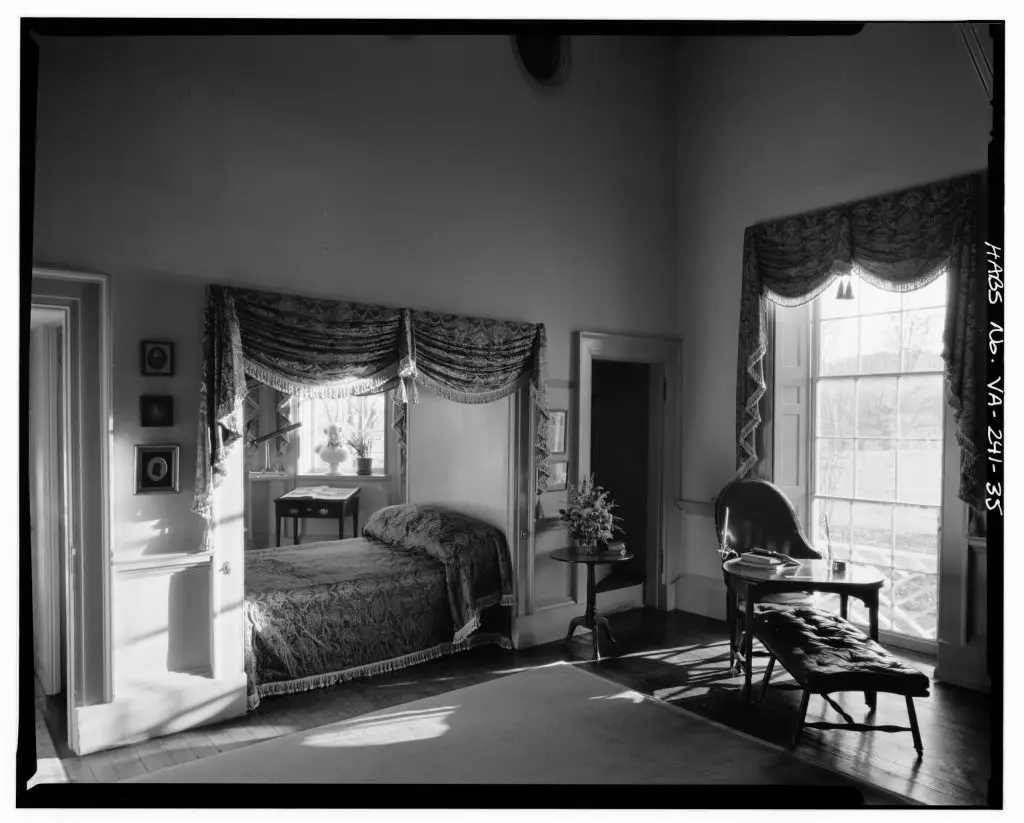
Master Bedroom, looking southwest (1978) (Wiki Image).
- Architectural Vision: Monticello was designed by Jefferson himself, reflecting his deep interest in architecture, classical design, and Enlightenment ideals. It served as his retreat where he could escape the public eye, indulge his intellectual pursuits, and enjoy the serenity of the Virginia countryside. Jefferson’s architectural innovations, such as the use of the dome and his emphasis on symmetry, made Monticello a unique and enduring symbol of his vision.
- Cultural and Intellectual Hub: Monticello was more than just a home; it was a cultural and intellectual hub where Jefferson could engage in his wide-ranging interests, including philosophy, science, and the arts. The estate housed an extensive library where Jefferson spent countless hours reading, writing, and corresponding with some of the leading thinkers of his time.
Scholar’s Haven
- Jefferson’s Library: Jefferson’s library at Monticello was one of the largest and most diverse collections of its time, containing books on various subjects, including philosophy, history, law, agriculture, and science. After the original library was sold to the government to rebuild the Library of Congress following its destruction during the War of 1812, Jefferson continued to collect books, reinforcing Monticello’s role as a scholar’s haven.
- Invention and Innovation: Monticello was also a place of invention and innovation. Jefferson designed various gadgets and tools to improve the efficiency of everyday tasks, from a revolving bookstand to a polygraph for duplicating letters. The estate itself was a testament to his inventive mind, with features like hidden dumbwaiters and innovative garden layouts that showcased his interest in practical solutions to daily challenges.
- Scientific Curiosity: Jefferson’s interest in science and nature was evident in how he managed Monticello. The gardens, orchards, and landscape were meticulously planned to reflect his interest in botany, agriculture, and horticulture. He also conducted various agricultural experiments, making Monticello a living laboratory where he could explore new farming techniques and crops.
Family Home
- Center of Family Life: Monticello was the heart of Jefferson’s family life. He lived there with his wife, Martha Wayles Skelton Jefferson, until she died in 1782, and their two surviving daughters, Martha and Mary. After Martha’s death, Jefferson maintained a close relationship with his daughters, and Monticello remained a central part of their lives.
- Grandchildren and Extended Family: Monticello was also home to Jefferson’s grandchildren, who played a significant role in his later life. The estate was a place where family gatherings were frequent, and Jefferson took an active role in the education and upbringing of his grandchildren, instilling in them his values and intellectual curiosity.
- Home After Public Service: Jefferson retired to Monticello after his presidency, where he spent the remaining years of his life. The estate provided him with a peaceful environment to reflect on his public service, engage in correspondence, and continue his scholarly pursuits.
Farming Practices

Vegetable Garden – 180 degrees (Wiki Image).
- Agriculture at Monticello: Monticello was a working plantation, and agriculture was central to its operations. Jefferson experimented with various crops, including tobacco, wheat, and vegetables. He was particularly interested in improving agricultural practices and was an early advocate for crop rotation, soil conservation, and using fertilizers to maintain soil fertility.
- Gardens and Orchards: The gardens at Monticello were both practical and experimental. Jefferson cultivated a wide range of vegetables, fruits, and ornamental plants, many rare or unusual in Virginia. The gardens were laid out in terraces, reflecting Jefferson’s aesthetic sensibilities and desire to use the hilly landscape efficiently.
- Sustainable Practices: Jefferson’s approach to farming was forward-thinking, focusing on sustainability and innovation. He experimented with new plant species, agricultural techniques, and tools, always seeking to improve the productivity and efficiency of his plantation. His farm journals, which detailed his agricultural practices, remain valuable records of early American farming.
Slave Labor
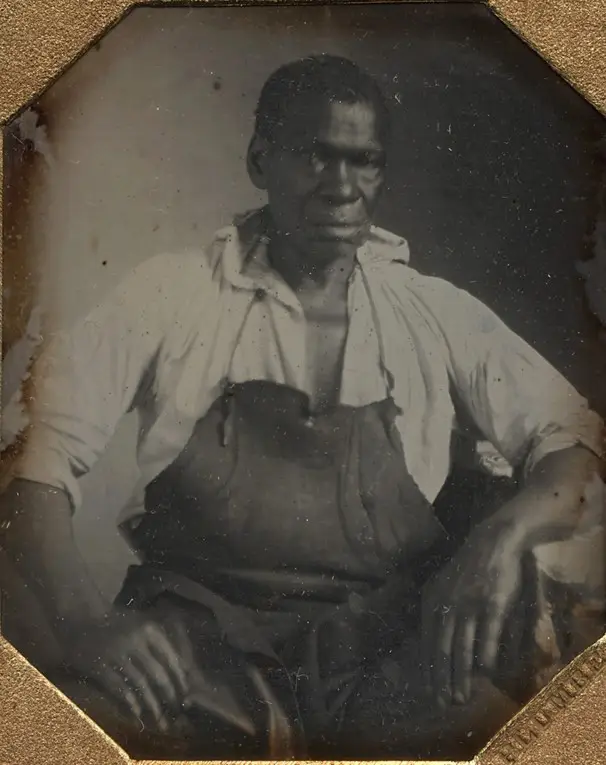
Isaac Jefferson, 1845, was a slave blacksmith at Monticello (Wiki Image).
- Central Role of Enslaved People: Like most plantations in the South, Monticello’s operations relied heavily on enslaved labor. The enslaved people at Monticello performed various tasks, from fieldwork and gardening to skilled trades like blacksmithing, carpentry, and cooking. Their labor was essential to the functioning of the estate, and they lived in a community known as Mulberry Row, located near the main house.
- Life on Mulberry Row: Mulberry Row was the center of activity for the enslaved community at Monticello. It was a bustling area with workshops, living quarters, and other facilities necessary for the plantation’s operations. The conditions on Mulberry Row varied, with some enslaved individuals living in log cabins while others resided in larger, more substantial structures. Despite their hardships, the enslaved community at Monticello developed their own social networks, culture, and traditions.
- Jefferson’s Views on Slavery: Jefferson’s relationship with slavery was complex and contradictory. While he publicly opposed the institution of slavery and called for its eventual abolition, he continued to own and profit from enslaved labor throughout his life. This contradiction between his ideals and practices is a central aspect of his legacy, and it has been the subject of extensive historical debate and reflection.
Sally Hemings
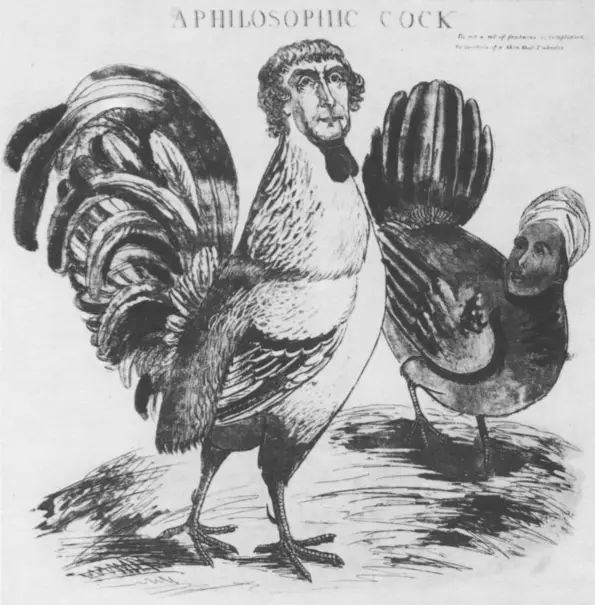
A caricature showing Thomas Jefferson and Sally Hemings as chickens, titled “A philosophic cock”; was created circa 1804 and attributed to James Akin (Wiki Image).
- Relationship with Jefferson: Sally Hemings was an enslaved woman at Monticello who had a long-term relationship with Thomas Jefferson. Historians believe that Hemings and Jefferson had at least six children together, four of whom survived to adulthood. This relationship has been the subject of significant historical research, reshaping our understanding of Jefferson’s life and legacy.
- Hemings Family at Monticello: Sally Hemings was part of the larger Hemings family, many of whom were enslaved there. The Hemingses were a prominent family on the estate, with several members holding skilled positions, such as chefs, blacksmiths, and seamstresses. Sally Hemings worked as a domestic servant and lived close to Jefferson in the main house.
- Legacy and Descendants: The descendants of Sally Hemings and Thomas Jefferson have played an essential role in preserving and interpreting this part of American history. The recognition of their lineage has brought attention to the complex and often painful legacy of slavery at Monticello and opened up new conversations about race, family, and American identity.
- Historical Acknowledgment: In recent years, Monticello has made significant efforts to acknowledge and interpret the life of Sally Hemings and the broader history of the enslaved community at the estate. This includes exhibits, tours, and educational programs that explore the lives of the enslaved people at Monticello and the impact of Jefferson’s relationship with Sally Hemings on his legacy.
Monticello remains a powerful symbol of the contradictions inherent in the founding of the United States—a place of intellectual achievement and innovation but also a site where the realities of slavery were ever-present. Through ongoing preservation and interpretation efforts, Monticello continues to educate and inspire visitors, offering a nuanced understanding of Jefferson’s life and legacy.
Monticello Today, Educational Initiatives, Symbol of Jeffersonian Ideals, Architectural Innovation, and Reflection of Contradictions.
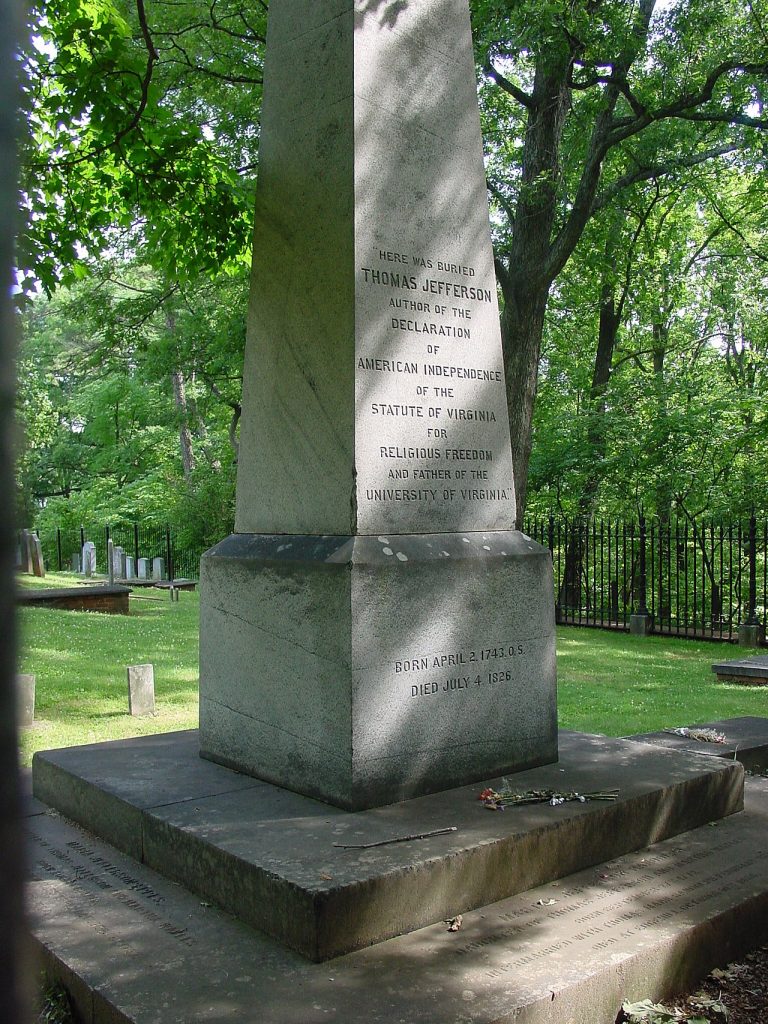
Jefferson’s gravesite at Monticello (Wiki Image).
Indeed, let’s explore Monticello’s multifaceted nature today, from its educational initiatives to its symbolic significance.
Monticello Today:
-
A Living Museum: Today, Monticello is a meticulously preserved historic site that offers visitors a glimpse into Thomas Jefferson’s life and times. Guided tours, interactive exhibits, and educational programs provide a deeper understanding of his legacy.
-
A UNESCO World Heritage Site: Monticello is a UNESCO World Heritage Site recognized for its architectural and historical significance, attracting visitors from around the world.
Educational Initiatives:
- The Thomas Jefferson Foundation: The Foundation oversees the preservation and interpretation of Monticello and offers a range of educational programs and resources for students, teachers, and the general public.
- Digital Initiatives: Monticello has embraced technology to expand its reach, offering virtual tours, online exhibits, and educational resources that make its history accessible to a global audience.
- Focus on Slavery: Monticello actively confronts the complex history of slavery, offering educational programs and exhibits that shed light on the lives of the enslaved people who lived and worked there.
Symbol of Jeffersonian Ideals:
- Champion of Liberty: Monticello symbolizes Jefferson’s unwavering commitment to individual liberty, religious freedom, and limited government. These ideals, enshrined in the Declaration of Independence, inspire and shape American democracy.
- Pursuit of Knowledge: The estate’s vast library and scientific instruments reflect Jefferson’s insatiable thirst for knowledge and his belief in the power of education to enlighten and empower individuals.
Architectural Innovation:
- Neoclassical Masterpiece: Monticello’s architecture showcases Jefferson’s deep appreciation for classical design and his innovative spirit. He incorporated elements from ancient Greek and Roman architecture, blending them with his unique ideas to create a harmonious and functional masterpiece.
- Technological Ingenuity: Jefferson’s fascination with technology is evident in the numerous inventions and innovations integrated into Monticello’s design, such as hidden beds, dumbwaiters, and a revolving bookstand.
Reflection of Contradictions:
- Slavery and Liberty: Monticello starkly reminds us of the inherent contradictions of Jefferson’s life and the early American republic. He was a champion of liberty who owned enslaved people, highlighting the complexities of American history and the ongoing struggle for equality.
- Legacy of Progress and Injustice: Monticello embodies the remarkable progress and the deep-seated injustices of America’s founding era. It challenges visitors to grapple with history’s complexities and recognize the ongoing work toward a more just and equitable society.
In conclusion, Monticello today is much more than a historic house. It’s a dynamic institution dedicated to preserving Jefferson’s legacy, educating the public, and fostering critical dialogue about America’s past and present. It is a powerful reminder that history is not static; it’s an ongoing conversation that shapes our understanding of ourselves and our nation.
Jefferson’s Declaration of Independence, Louisiana Purchase, Lewis and Clark Expedition, Embargo Act, Monticello as a Symbol.
Thomas Jefferson is best known for his pivotal role in shaping the early United States, mainly through his authorship of the Declaration of Independence, orchestration of the Louisiana Purchase, commissioning of the Lewis and Clark expedition, and enacting the Embargo Act. His home, Monticello, serves as a lasting symbol of his ideals and legacy. Here’s an exploration of these aspects:
Declaration of Independence
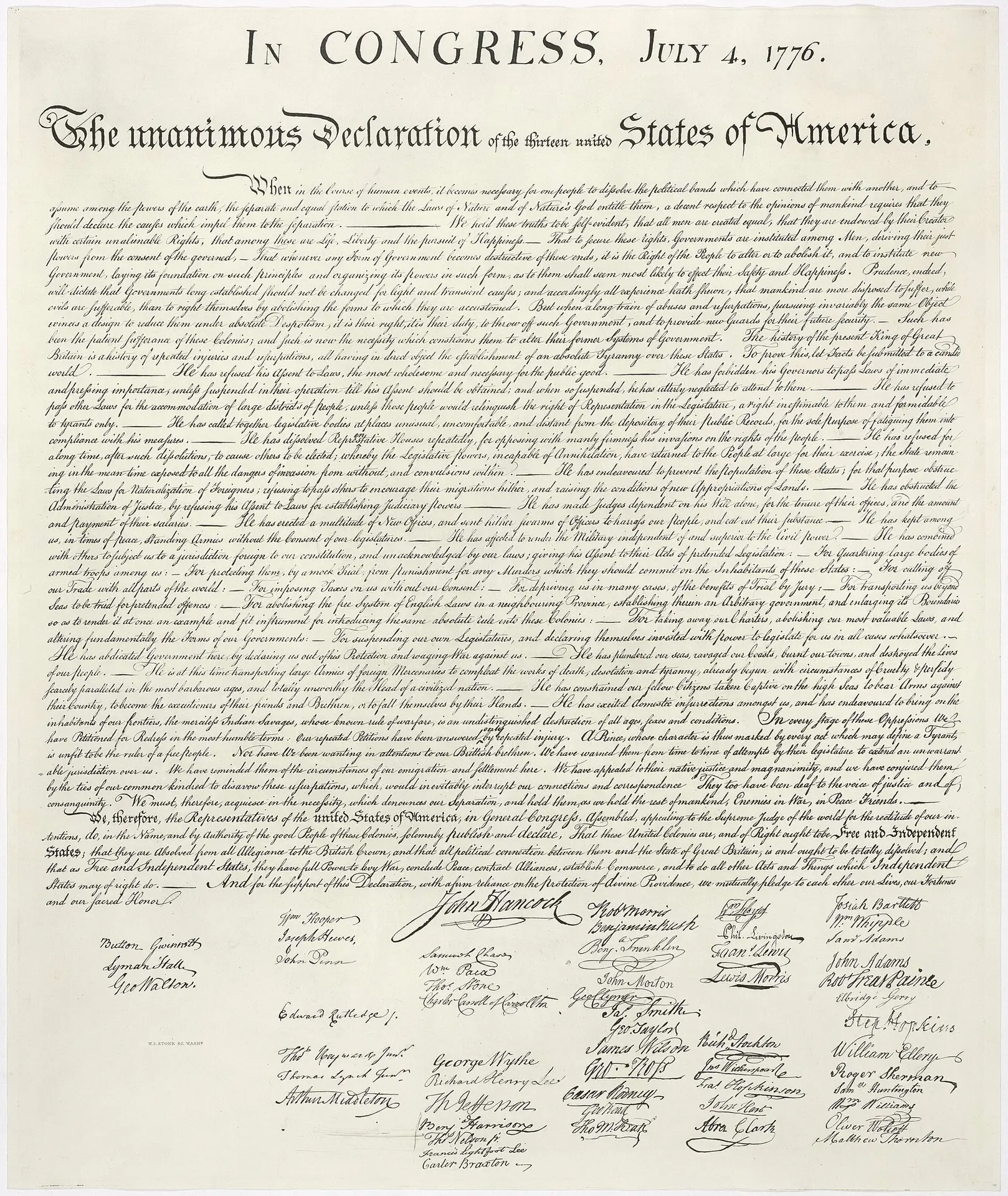
The Declaration of Independence, which Jefferson primarily wrote in isolation between June 11 and 28, 1776, from a floor he was renting in a home at 700 Market Street in Center City Philadelphia, are “the most potent and consequential words in American history,” historian Joseph Ellis later wrote (Wiki Image).
- Authorship: In June 1776, the Continental Congress tasked Thomas Jefferson with drafting the Declaration of Independence. At 33, Jefferson drew upon Enlightenment principles, particularly the ideas of natural rights and government by consent of the governed, to craft a document that would articulate the American colonies’ reasons for seeking independence from Great Britain.
- Core Principles: The Declaration of Independence is renowned for its assertion that “all men are created equal” and are endowed with “unalienable rights,” including “life, liberty, and the pursuit of happiness.” This statement of fundamental human rights was revolutionary and has had a profound impact on democratic movements worldwide.
- Legacy: Jefferson’s Declaration is considered one of the most critical documents in American history. It not only justified the colonies’ break from Britain but also set forth a vision for a new nation based on equality and individual rights, even though the realities of slavery and inequality persisted. The Declaration continues to symbolize American ideals and has been invoked by various movements seeking to expand rights and freedoms.
Louisiana Purchase
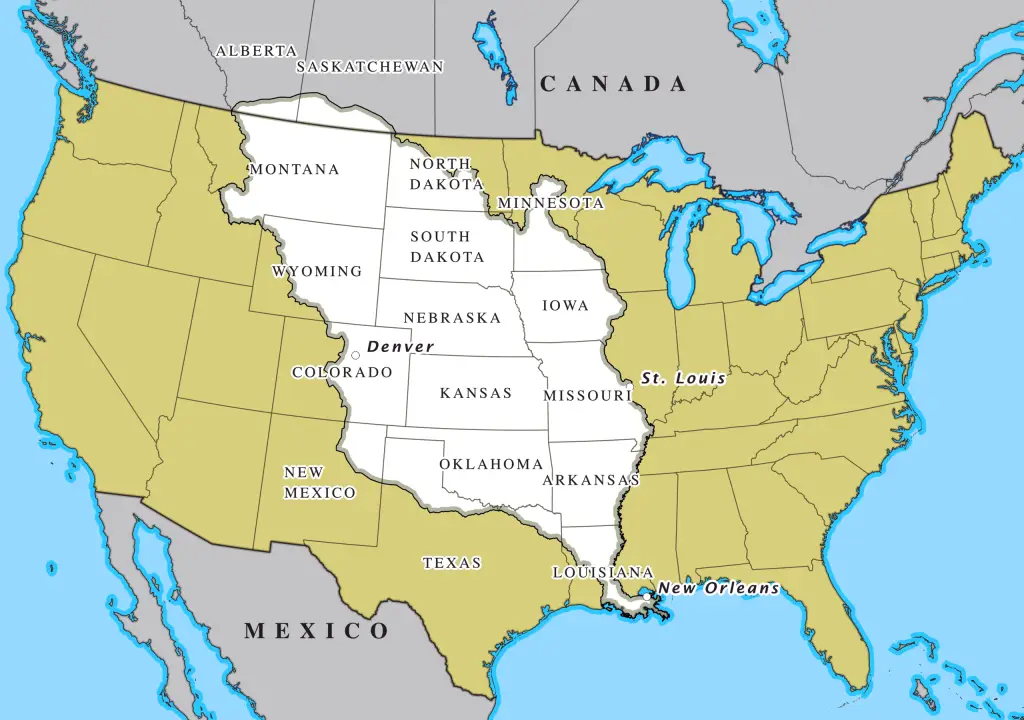
The 1803 Louisiana Purchase, completed during Jefferson’s presidency, added 827,987 square miles (2,144,480 square kilometers), doubling the United States’ geographic size (Wiki Image).
- Expansion of Territory: As President, one of Jefferson’s most significant achievements was the Louisiana Purchase in 1803. The purchase involved acquiring approximately 828,000 square miles of territory from France, effectively doubling the size of the United States. This land stretched from the Mississippi River to the Rocky Mountains and from the Gulf of Mexico to Canada.
- Constitutional Dilemma: The acquisition posed a constitutional dilemma for Jefferson, who had long advocated for a strict interpretation of the Constitution. The Constitution did not explicitly grant the federal government the power to acquire new territory, yet Jefferson proceeded with the purchase, believing it was essential for the nation’s future growth. This decision marked a significant moment in the expansion of presidential power.
- Impact: The Louisiana Purchase had a profound impact on the United States. It provided vast new lands for settlement and agriculture and secured control of the Mississippi River, a vital trade route. It also set the stage for westward expansion, becoming a central theme in American history.
Lewis and Clark Expedition
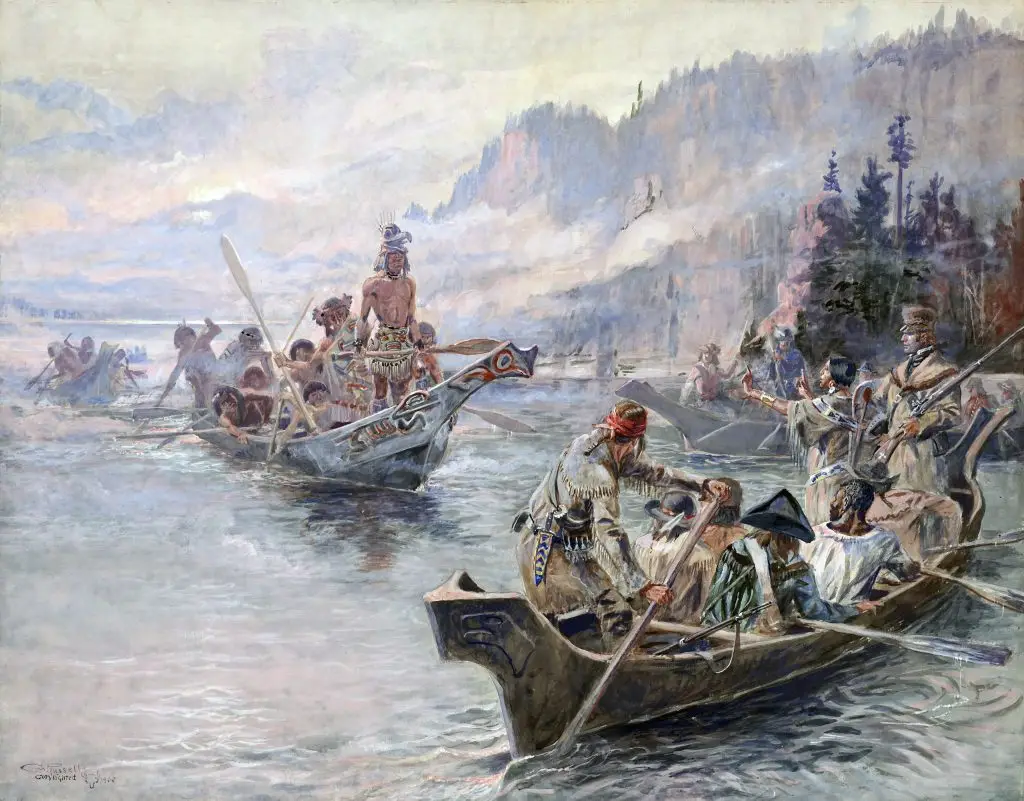 Lewis and Clark on the Lower Columbia, a 1905 portrait by Charles Marion Russell depicting Lewis and Clark’s expedition on the Columbia River during Jefferson’s presidency (Wiki Image).
Lewis and Clark on the Lower Columbia, a 1905 portrait by Charles Marion Russell depicting Lewis and Clark’s expedition on the Columbia River during Jefferson’s presidency (Wiki Image).
- Exploration of the West: In 1804, Jefferson commissioned the Lewis and Clark Expedition, also known as the Corps of Discovery, to explore the newly acquired Louisiana Territory and beyond. Meriwether Lewis and William Clark led the expedition to map the region, establish relations with Native American tribes, and assess the natural resources and potential for settlement.
- Scientific and Geographic Contributions: The expedition lasted until 1806 and provided valuable geographic and scientific knowledge about the vast western territories. Lewis and Clark documented numerous plant and animal species, mapped the region, and gathered information crucial for future exploration and settlement.
- Significance: The Lewis and Clark Expedition helped to solidify American claims to the western territories and fueled the nation’s vision of Manifest Destiny—the belief that the United States was destined to expand across the North American continent. It also marked a significant chapter in the history of exploration and the relationship between the U.S. government and Native American tribes.
Embargo Act
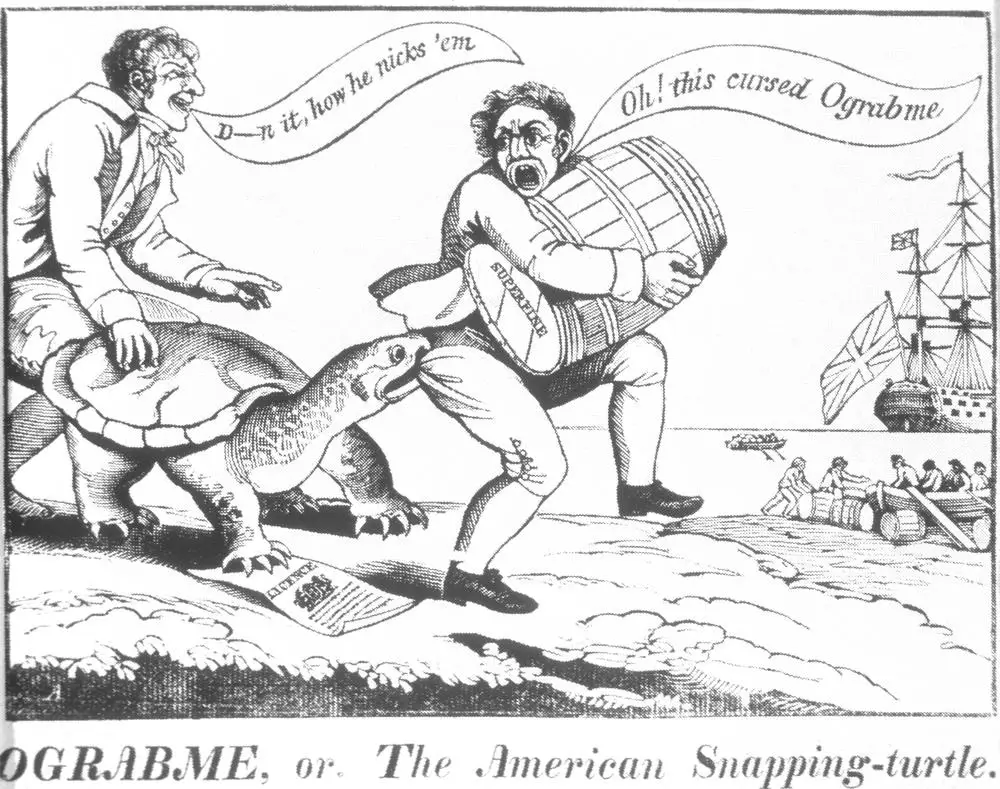 An 1807 political cartoon on the Embargo Act depicts merchants dodging the “Ograbme,” which is “Embargo” spelled backward (Wiki Image).
An 1807 political cartoon on the Embargo Act depicts merchants dodging the “Ograbme,” which is “Embargo” spelled backward (Wiki Image).
- Response to Foreign Conflicts: In 1807, Jefferson faced increasing challenges from European powers, particularly Britain and France, engaged in the Napoleonic Wars. Both nations were interfering with American trade, and Britain’s practice of impressment—forcing American sailors into the British Navy—was a particular source of tension. In response, Jefferson enacted the Embargo Act to pressure Britain and France by prohibiting American ships from trading with foreign ports.
- Economic Impact: The Embargo Act had significant and largely negative financial consequences for the United States, particularly for merchants and shipowners in New England, who were heavily dependent on international trade. The embargo led to widespread smuggling, economic downturn, and increased domestic opposition to Jefferson’s policies.
- Political Consequences: The failure of the Embargo Act to achieve its intended goals damaged Jefferson’s popularity and was a significant factor in the tensions leading up to the War of 1812. The Act was eventually repealed in 1809, shortly before Jefferson left office, but its effects lingered, highlighting the challenges of maintaining neutrality in a world of competing imperial powers.
Monticello as a Symbol
- Architectural Masterpiece: Monticello, Jefferson’s self-designed estate, is more than just a personal residence; it symbolizes his intellectual pursuits, values, and vision for America. The estate reflects his deep appreciation for classical architecture, belief in the harmony between human-made structures and the natural environment, and commitment to innovation and practicality.
- Representation of Jefferson’s Ideals: Monticello represents Jefferson’s ideals of liberty, democracy, and self-sufficiency. The estate’s design incorporates features that emphasize these themes, such as the integration of the house with the surrounding landscape, the emphasis on functionality and symmetry, and the use of the latest technologies of the time.
- Complex Legacy: While Monticello symbolizes Jefferson’s achievements and ideals, it also embodies his life’s contradictions. The estate was built and maintained by enslaved laborers, and the reality of slavery at Monticello starkly contrasts with Jefferson’s public advocacy for liberty and equality. This dual legacy is central to the estate’s ongoing interpretation and education efforts today.
- Monticello Today: Monticello is now a UNESCO World Heritage Site and a museum dedicated to preserving Jefferson’s legacy. Visitors can explore the complexities of his life, including his contributions to American independence and governance, his intellectual pursuits, and the realities of life at a plantation dependent on enslaved labor. The estate offers a nuanced understanding of Jefferson’s impact on American history and the lasting significance of his ideas.
In summary, Thomas Jefferson’s life and legacy are deeply intertwined with the foundational moments in American history, from the Declaration of Independence to the nation’s expansion through the Louisiana Purchase. Monticello, his beloved home, remains a powerful symbol of his intellectual and architectural achievements and the complex realities of his life, including his relationship with slavery.
James Madison: Montpelier
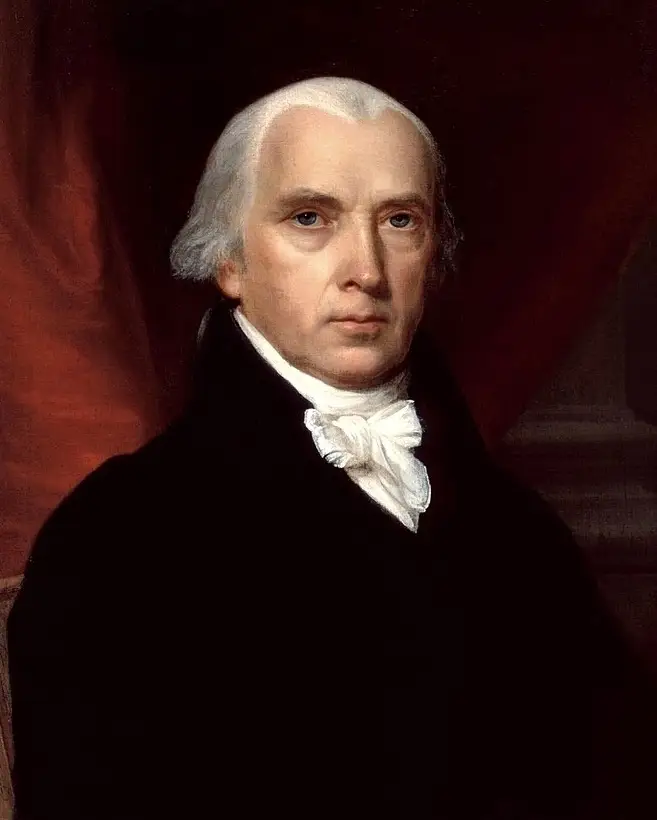
James Madison (Wiki Image).
James Madison on the Constitution:
- “The Constitution of the United States was created by the people of the United States composing the respective states, who alone had the right.” — James Madison
James Madison on Liberty:
- “If men were angels, no government would be necessary. If angels were to govern men, neither external nor internal controls on government would be necessary.” — James Madison, Federalist No. 51
James Madison on Government and Power:
- “The accumulation of all powers, legislative, executive, and judiciary, in the same hands, whether of one, a few, or many, and whether hereditary, self-appointed, or elective, may justly be pronounced the very definition of tyranny.” — James Madison, Federalist No. 47
James Madison on Knowledge and Governance:
- “Knowledge will forever govern ignorance, and a people who mean to be their own governors must arm themselves with the power which knowledge gives.” — James Madison
James Madison on the Separation of Church and State:
- “The purpose of separation of church and state is to keep forever from these shores the ceaseless strife that has soaked the soil of Europe in blood for centuries.” — James Madison
James Madison on Property Rights:
- “Government is instituted to protect property of every sort… This being the end of government, that alone is a just government which impartially secures to every man whatever is his own.” — James Madison, National Gazette Essay, March 27, 1792
James Madison on Montpelier:
- “I wish I had more [funds] to expend on Montpelier, but the time for any important expense has passed.” — James Madison, reflecting on his home and estate
James Madison on Checks and Balances:
- “The truth is that all men having power ought to be mistrusted.” — James Madison
James Madison on Religious Freedom:
- “We hold it for a fundamental and undeniable truth, that religion or the duty which we owe to our Creator and the manner of discharging it, can be directed only by reason and conviction, not by force or violence.” — James Madison, Memorial, and Remonstrance Against Religious Assessments, 1785
James Madison on Republicanism:
- “A republic, by which I mean a government in which the scheme of representation takes place, opens a different prospect and promises the cure for which we are seeking.” — James Madison, Federalist No. 10
| Year | Event/Development |
|---|---|
| 1723 | James Madison’s grandfather, Ambrose Madison, acquired the land to become Montpelier. |
| 1732 | James Madison Sr., James Madison’s father, is born in Montpelier. |
| 1755 | The central core of the mansion at Montpelier is built. |
| 1760s | James Madison Jr. spends his childhood at Montpelier. |
| 1770s – 1780s | James Madison Jr. was actively involved in the American Revolution and the drafting of the U.S. Constitution. Between political duties, he spent time at Montpelier. |
| 1794 | James Madison Jr. marries Dolley Payne Todd. |
| 1797 | James Madison Jr. retires from Congress and returns to Montpelier, expanding the house. |
| 1801 – 1809 | James Madison Jr. serves as Secretary of State under President Thomas Jefferson, residing primarily in Washington, D.C. |
| 1809 – 1817 | James Madison Jr. served as the fourth President of the United States. Montpelier is maintained, but they are absent. |
| 1817 – 1836 | James and Dolley Madison return to Montpelier and live there in retirement. The house is further expanded and renovated. |
| 1836 | James Madison Jr. dies at Montpelier. |
| 1844 | Dolley Madison sells Montpelier due to financial difficulties. |
| 1901 | William du Pont acquires Montpelier. The du Ponts further expanded and modified the house. |
| 1984 | The National Trust for Historic Preservation acquires Montpelier. |
| 2000s – Present | Extensive archaeological and historical research and restoration efforts are undertaken to restore Montpelier to its appearance during James Madison’s time. The site becomes a center for constitutional education and studying James Madison’s legacy. The focus shifts to include the history of enslaved people at Montpelier. |
Inside James Madison’s Montpelier
(YouTube video)
James Madison’s Montpelier, a Museum of American History
(YouTube video)
Location: Orange County, Virginia
Overview: Montpelier, the lifelong home of James Madison, the fourth President of the United States and the “Father of the Constitution,” is a significant historical and architectural site that offers insights into his life, work, and legacy.
Historical Significance
Early Years
- Family Estate: Montpelier was originally part of a land grant received by Madison’s grandfather. James Madison was born at the estate in 1751 and spent much of his early life there.
- Inheritance: Madison inherited Montpelier in 1801, and it remained his home until he died in 1836.
Political Career
- Retreat and Sanctuary: Montpelier served as Madison’s retreat during his political career, including his time as Secretary of State and President of the United States. It was at Montpelier that Madison prepared for the Constitutional Convention and where he retired after his presidency.
- Wife Dolley Madison: Dolley Madison, his wife, was a notable First Lady known for her social graces and influence in Washington, D.C. She played a significant role in making Montpelier a center of hospitality and political discourse.
Architecture and Design
Original Structure
- Georgian Design: Madison’s father built the original house in the 1760s, a typical Georgian structure reflecting the architectural styles of the time.
Madison’s Modifications
- Expansion: Madison expanded Montpelier in the early 19th century to accommodate his status and needs. He added two wings to the house, resulting in a 22-room mansion. The expansions included a drawing room, library, and additional bedrooms.
- Federal Style: The renovations incorporated elements of the Federal architectural style, popular in the United States during the late 18th and early 19th centuries.
Notable Features
- Temple: Madison used a small, classical-style building known as the “Temple” as a study and retreat.
- Garden: Madison designed a formal garden that reflects the landscaping trends of the period. The garden includes a variety of plants and is a central feature of the estate.
Life at Montpelier
Agricultural Practices
- Plantation: Montpelier was a working plantation where Madison practiced scientific farming techniques. He experimented with crop rotation, soil conservation, and other agricultural methods.
- Slave Labor: The plantation relied on enslaved African Americans for labor. Madison owned over 100 slaves during his lifetime, who worked in the fields, maintained the house, and supported the estate’s operations.
Intellectual Pursuits
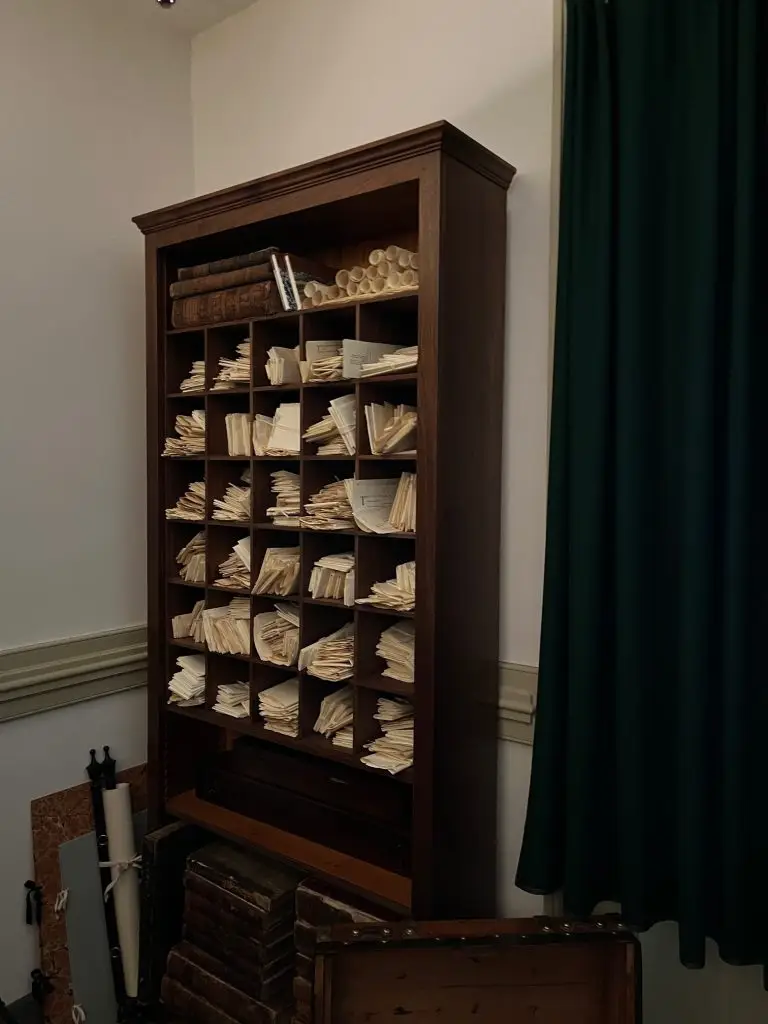
James Madison’s letters were organized by month (organized 30 days) (personal image).
- Library: Madison maintained an extensive library at Montpelier, reflecting his lifelong commitment to learning and scholarship. His collection included books on law, politics, history, and philosophy.
- Correspondence: Montpelier was a hub of intellectual activity. Madison corresponded with numerous political leaders, philosophers, and scholars worldwide.
Legacy and Preservation
Montpelier Foundation
- Restoration: The Montpelier Foundation has undertaken extensive restoration work to return the estate to its early 19th-century appearance. This effort includes archaeological excavations and research to uncover more about Madison’s and the enslaved community’s daily lives.
- Education: Montpelier serves as an educational center, offering programs about Madison’s contributions to the Constitution, American governance, and the history of slavery in the United States.
Historic Site
- Museum: Montpelier is now a museum open to the public. Visitors can tour the mansion, gardens, and restored slave quarters, comprehensively understanding Madison’s life and legacy.
- Exhibits: The site features exhibits on Madison’s role in the founding of the United States, his political career, and the broader historical context of his time.
Conclusion
Montpelier, James Madison’s Virginia home, is a testament to his life, achievements, and enduring legacy. As both a private retreat and a center of political and intellectual activity, Montpelier reflects Madison’s significant contributions to American history. Today, it serves as a historic site and educational center, preserving Madison’s memory and the complex history of the early United States.
Montpelier
James Madison Montpelier Family Estate, Inheritance, Retreat and Sanctuary, and Wife Dolley Madison.
James Madison’s Montpelier, located in Orange County, Virginia, is a historic estate that served as the lifelong home of the fourth President of the United States. The estate, rich in history and significance, is closely tied to Madison’s personal life, contributions to the nation, and legacy.
Montpelier: The Family Estate
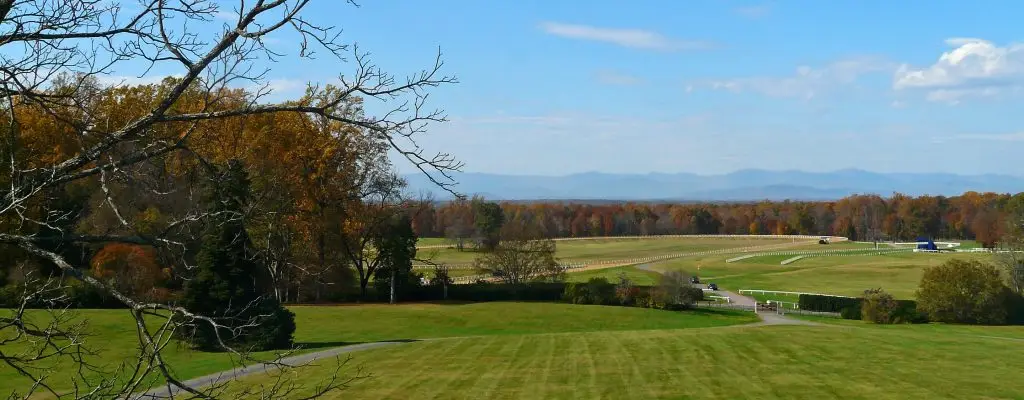
View of the Blue Ridge Mountains from the second floor of the front of James Madison’s Montpelier, Orange County, VA (Wiki Image).
- Origins and Development: Montpelier was initially owned by James Madison’s grandfather, Ambrose Madison, and later by his father, James Madison Sr. The estate was initially a plantation, with tobacco as its primary crop. Over time, the estate was expanded and developed, particularly under James Madison Jr.’s ownership, who made it his lifelong home.
- Architecture and Layout: The Montpelier mansion is a fine example of Georgian and neoclassical architecture. Madison expanded the house significantly after marrying Dolley, making it a grand estate suitable for a statesman of his stature.
Inheritance and Legacy
- Passing Down: James Madison inherited Montpelier from his father in 1801. Madison was deeply connected to the estate, and it served as his primary residence throughout his life, even during his presidency.
- Post-Madison Era: After Madison died in 1836, the estate eventually fell into financial trouble. Dolley Madison, facing financial difficulties, was forced to sell Montpelier in 1844. The estate passed through several hands before being purchased and restored by the du Pont family in the early 20th century.
- Restoration: The Montpelier Foundation, established in the 1980s, now manages the estate. They have worked to restore Montpelier to its appearance during Madison’s time, making it a site of historical preservation and education.
Retreat and Sanctuary
- Retirement Home: Montpelier was Madison’s retreat after his presidency. Here, he devoted himself to writing, farming, and mentoring the next generation of American leaders. He also reflected on his life’s work and the nation’s future.
- Philosophical Sanctuary: The estate also served as a sanctuary where Madison could engage in deep thought and study. It was a place where he could retreat from the public eye and focus on his philosophical and political writings, including his contributions to the Federalist Papers.
Dolley Madison: The First Lady of Montpelier
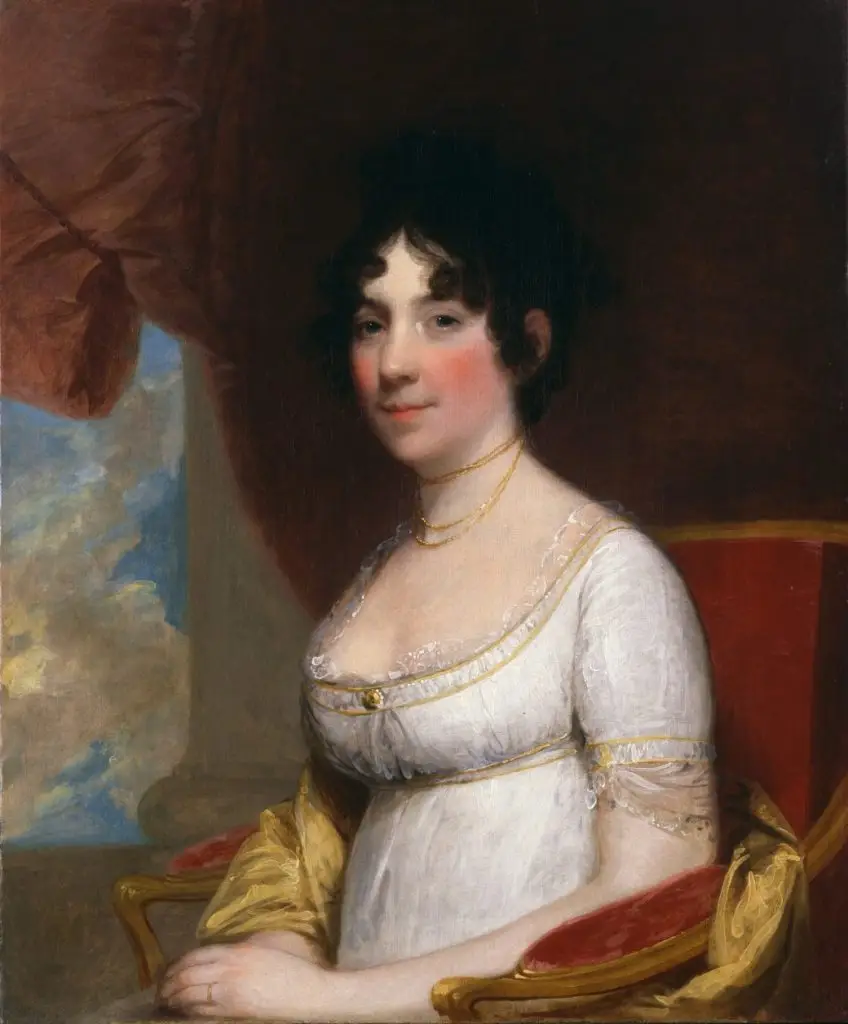
Dolley Madison 1804 portrait by Gilbert Stuart (Wiki Image).
- Marriage and Partnership: Dolley Payne Todd married James Madison in 1794, and their partnership became one of the most famous in American history. As First Lady, Dolley was known for her social graces, political acumen, and the establishment of many traditions that continue in the White House today.
- Role at Montpelier: Dolley played a crucial role in Montpelier’s life, managing the household and the estate and hosting numerous dignitaries and visitors. Her charm and hospitality made Montpelier a vibrant social center.
- Later Years: After James Madison’s death, Dolley faced financial hardships but remained a revered figure in American society. She lived in Washington, D.C., but retained a deep connection to Montpelier until she was forced to sell the estate. Despite her struggles, Dolley’s legacy as one of the most influential First Ladies in American history remains strong.
Montpelier stands today not only as a symbol of James Madison’s contributions to the United States but also as a testament to the life and legacy of both James and Dolley Madison. The estate is a place of reflection on the early days of the American Republic and the personal lives of those who helped shape its foundation.
James Madison Montpelier Georgian Design, Expansion, Federal Style, Temple, and Garden.
James Madison’s Montpelier estate is an important architectural and historical site that reflects the evolving tastes and influences of the period. The estate features a blend of Georgian and Federal architectural styles, including a prominent temple and formal gardens, contributing to its grandeur.
Georgian Design
- Original Construction: The original house at Montpelier was constructed by James Madison’s father, James Madison Sr., in the 1760s. This initial structure was built in the Georgian style, popular in the American colonies during the 18th century. Georgian architecture is characterized by symmetry, proportion, and adherence to classical details like pediments, columns, and decorative cornices.
- Georgian Features: The original Montpelier house was a two-story brick building with a simple, balanced façade. Georgian design typically uses brick, hipped roofs, and classical elements like pilasters and transoms above doors.
Expansion and Federal Style
- James Madison’s Expansion: When James Madison inherited Montpelier in 1801, he expanded the house significantly to accommodate his needs, particularly after his marriage to Dolley Madison. The most notable expansion occurred in 1809 when Madison became President.
- Federal Style Influence: The expansion incorporated elements of the Federal style, which was popular in the early 19th century. Federal architecture is known for its refinement and elegance, featuring delicate ornamentation, elliptical and fan-shaped windows, and a focus on symmetry.
- New Additions: Madison added wings to the original structure, expanding the house to include more rooms, a large portico, and a new façade that brought the house more in line with the neoclassical trends of the time. The Federal style elements gave the house a more refined and elegant appearance, with lighter and more decorative details than the more robust Georgian style.
The Temple
- Design and Purpose: One of the most iconic features of the Montpelier estate is the temple, a small, classical structure located in the garden. The Roman-style pavilion temple was likely designed for contemplation and relaxation. It also served a practical purpose, built over an icehouse that stored ice and perishable goods.
- Symbolism: The temple’s design reflects the neoclassical ideals that were popular during Madison’s time, symbolizing a connection to ancient Roman and Greek democratic principles, which Madison deeply admired and which influenced his political philosophy.
The Garden
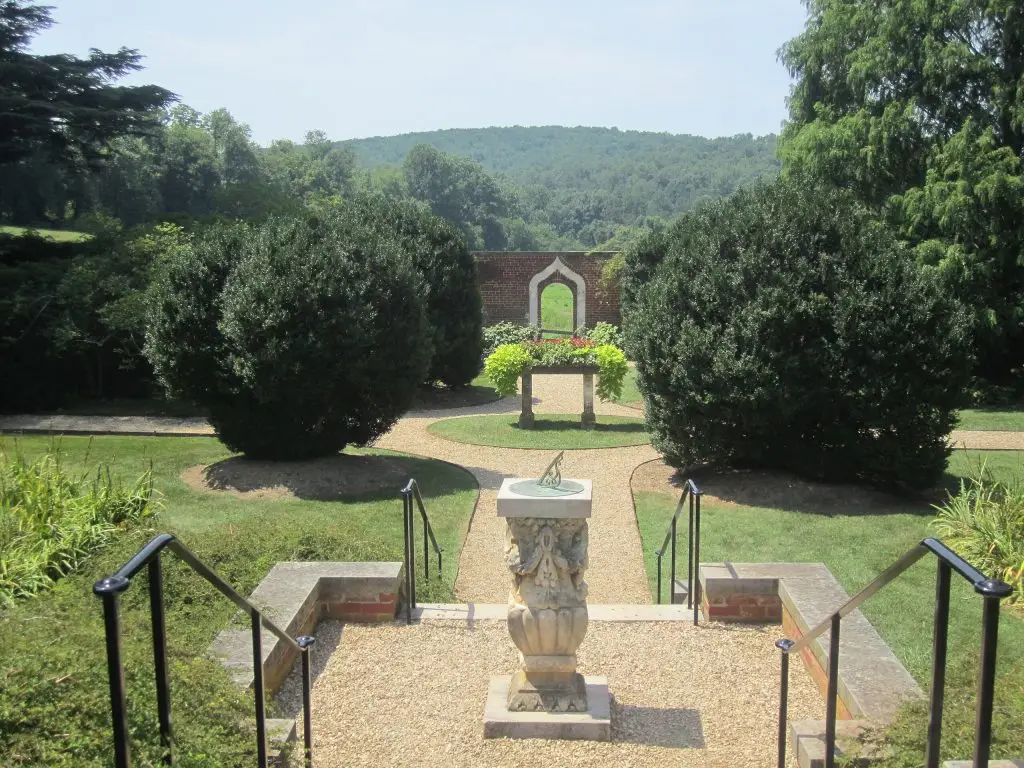
Entrance to the gardens at Montpelier (Wiki Image).
- Original Layout: The gardens at Montpelier were initially laid out during James Madison Sr.’s time, with the typical Georgian approach of symmetrical, formal gardens common in 18th-century estates. These gardens complement the house’s architecture and create a sense of order and beauty.
- Dolley Madison’s Influence: Dolley Madison took an active role in developing the gardens. She expanded them, incorporating more ornamental plants and flowers and creating social gatherings and relaxation spaces. The gardens became a key feature of the estate, reflecting both English landscape traditions and American ideals of natural beauty.
- Restoration: The gardens have been restored to reflect the period during which James and Dolley Madison lived at Montpelier. The formal gardens include boxwood-lined paths, flowering plants, and trees, recreating the environment that the Madisons would have enjoyed.
Architectural and Cultural Significance
Montpelier’s blend of Georgian and Federal styles, combined with its classical temple and carefully designed gardens, makes it a significant example of early American architecture and landscape design. The estate reflects James Madison’s stature as a statesman and intellectual and Dolley Madison’s influence on social and domestic life. Together, they created a residence that was a personal retreat and a symbol of the new nation’s ideals and aspirations.
James Madison Montpelier’s Painting, Furniture, and Sculpture.
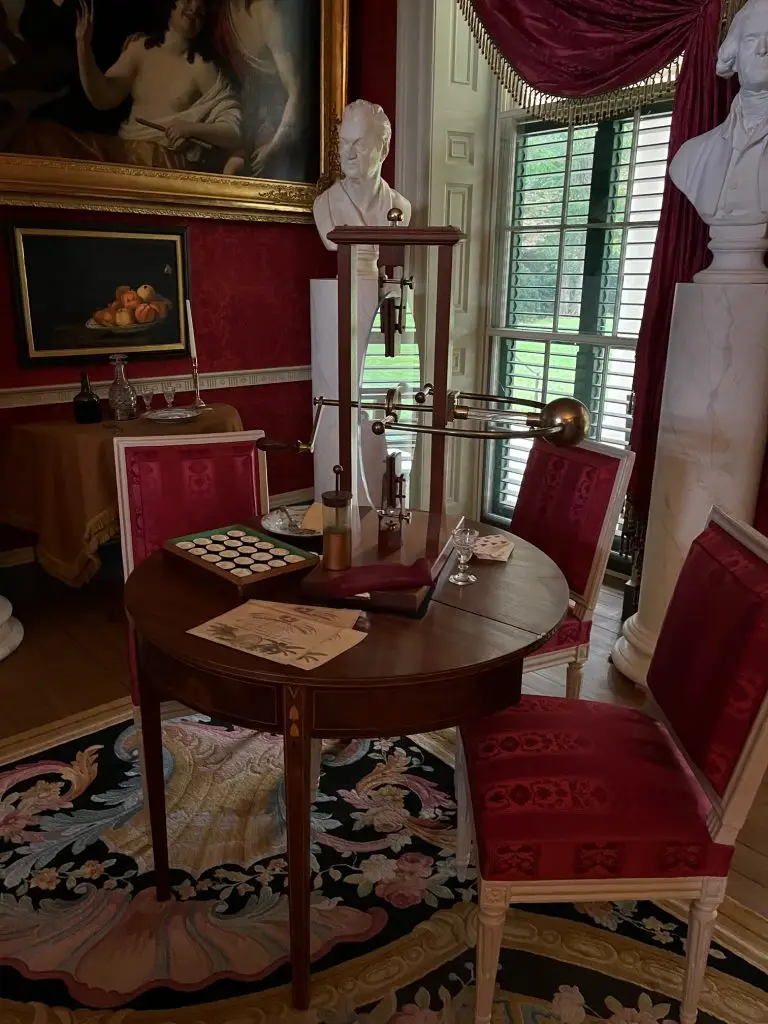
(personal image).
Certainly! Here are some images showcasing the paintings, furniture, and sculptures at James Madison’s Montpelier.
Paintings:
-
- Portraits of James and Dolley Madison: These portraits, painted by artists like Gilbert Stuart and Charles Willson Peale, are prominently displayed at Montpelier, offering a glimpse into the lives of the former President and First Lady.
-
- Landscapes and Historical Scenes: Paintings depicting the surrounding landscapes and scenes from American history can also be found throughout the house, providing context and adding to the ambiance.
Furniture:
-
- Original Madison Family Furniture: Many pieces of furniture, including chairs, tables, and desks belonging to the Madisons, have been carefully preserved and displayed at Montpelier. These pieces offer insight into their daily lives and tastes.
-
- Period Furniture: In addition to the original pieces, Montpelier also features period furniture that complements the historical setting and helps to recreate the atmosphere of the early 19th century.
Sculpture:
-
- Busts of Notable Figures: Several busts of prominent figures from American history, including George Washington and Thomas Jefferson, adorn the rooms and hallways of Montpelier.
-
- Decorative Sculptures: Smaller sculptures and figurines can also be found throughout the house, adding decorative touches and reflecting the aesthetic preferences of the time.
These are just a few examples of the art and furnishings at Montpelier. This historic site offers a fascinating glimpse into James Madison’s and his family’s lives and times.
James Madison Montpelier Plantation, Slave Labor, Library, and Correspondence.
Indeed, let’s explore the multifaceted aspects of James Madison’s Montpelier, including its role as a plantation reliant on slave labor, its significance as a center of intellectual pursuit, and the preservation of Madison’s correspondence.
Montpelier Plantation:
Montpelier was not merely a grand estate but also a working plantation that relied heavily on the labor of enslaved African Americans. These individuals toiled in the fields, cultivating crops such as tobacco and wheat, and also performed various domestic tasks within the main house. The plantation’s operation was integral to Madison’s livelihood, but it also served as a stark reminder of the injustice and brutality of slavery in early America.
Slave Labor at Montpelier:
The enslaved community at Montpelier numbered in the hundreds, and their labor was essential to the functioning of the estate. Their contributions span various tasks, from agricultural work to skilled craftsmanship. Despite their vital role, they were denied basic human rights and subjected to a system of oppression and exploitation.
Library and Intellectual Pursuit:
James Madison was a man of profound intellect and a voracious reader. His library at Montpelier, once containing thousands of volumes, was a testament to his thirst for knowledge and commitment to lifelong learning. It served as a resource for his political and philosophical writings and a place for quiet contemplation and study.
Correspondence:
Madison was a prolific writer, and his extensive correspondence provided invaluable insights into his thoughts, ideas, and interactions with other key figures of the early American republic. These letters, carefully preserved at Montpelier, offer a window into the political and social landscape of the time and shed light on Madison’s pivotal role in shaping the nation’s founding documents and institutions.
Conclusion:
Montpelier is a powerful reminder of the achievements and the contradictions of James Madison’s life and the early American republic. It was a place of intellectual pursuit, political discourse, and family life but also a site of enslaved labor and the inherent injustices of the era. Today, Montpelier stands as a testament to the complexity of American history, challenging visitors to grapple with the past while celebrating the enduring legacy of the “Father of the Constitution.”
Montpelier Foundation Restoration, Education, Museum, and Exhibits.
The Montpelier Foundation is dedicated to preserving the legacy of James Madison, the “Father of the Constitution,” and his historic estate, Montpelier. It strives to accomplish this through a combination of:
Restoration:
-
Meticulous Research and Preservation: The Foundation has invested significant resources in researching and restoring Montpelier to its original state, including the main house, gardens, and surrounding landscape.
-
Archaeological Exploration: Ongoing archaeological excavations are unearthing new insights into the lives of both the enslaved community and the Madison family, contributing to a more comprehensive understanding of Montpelier’s history.
-
Preservation of the Landscape: Beyond the buildings, the Foundation is dedicated to conserving the surrounding landscape, ensuring that the natural beauty and agricultural heritage of Montpelier are maintained for future generations.
Education:
-
Engaging Exhibits and Programs: The Foundation offers a wide range of educational programs and exhibits that delve into James Madison’s life and times, the complexities of slavery in early America, and the broader context of American history.
-
Focus on the Enslaved Community: The Foundation actively works to tell the complete story of Montpelier, including the experiences of the enslaved people who lived and worked there. Their voices and contributions are central to the Foundation’s educational mission.
Museum:
-
The David M. Rubenstein Visitor Center: This modern, state-of-the-art facility serves as the gateway to Montpelier, providing visitors with a comprehensive introduction to the estate and its history.
-
Permanent and Rotating Exhibits: The Visitor Center houses both permanent and rotating exhibits that explore various aspects of Montpelier’s past, including Madison’s political career, his relationship with Dolley Madison, and the daily lives of enslaved people on the plantation.
Exhibits (Current and Notable):
-
“The Mere Distinction of Colour”: This groundbreaking exhibit explores the lives of the enslaved community at Montpelier, highlighting their resilience, resistance, and contributions to the estate.
-
“Color Through a Child’s Eyes”: This exhibit invites children and their caregivers to explore the complexities of race and slavery from a child’s perspective.
-
“Mysteries of Montpelier”: This exhibit showcases how Montpelier has changed through time, using artifacts from the Foundation’s collection, archaeological finds, and historic building materials.
The Montpelier Foundation is vital in preserving and interpreting this significant historical landmark. Through its restoration efforts, educational programs, museum exhibits, and ongoing archaeological research, the Foundation ensures that Montpelier continues to serve as a powerful reminder of America’s complex past and an inspiration for its future.
Madison’s Foreign and Domestic Policy Impact, The Federalist Papers, The War of 1812, and Montpelier as a Symbol.
James Madison, the fourth President of the United States (1809-1817), played a crucial role in shaping the early American republic. His contributions to foreign and domestic policy were significant, and his work on The Federalist Papers, his leadership during the War of 1812, and his Virginia estate, Montpelier, offer deep insights into his legacy.
The Federalist Papers:
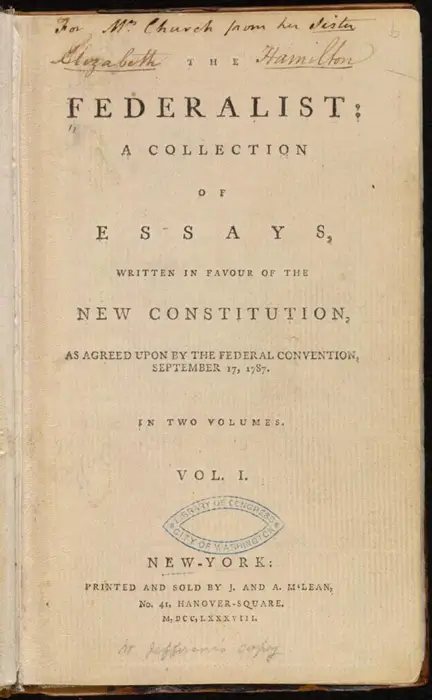
Title page of the first collection of The Federalist (1788). This volume was a gift from Alexander Hamilton‘s wife, Elizabeth Schuyler Hamilton, to her sister Angelica (Wiki Image).
- Foundation of the Constitution: Before his presidency, Madison was a leading figure in the drafting and ratifying the U.S. Constitution. Alongside Alexander Hamilton and John Jay, he co-authored The Federalist Papers, a series of 85 essays advocating for the ratification of the Constitution. Madison’s essays, particularly Federalist No. 10 and No. 51, are among the most famous. In these, he argued for the importance of a large republic to control factions and the necessity of checks and balances within government to prevent tyranny.
- Impact: The Federalist Papers significantly influenced the interpretation of the Constitution and continue to be cited in legal and political discourse. Madison’s vision of a strong yet balanced federal government has shaped the structure and function of the U.S. government since its inception.
Foreign Policy Impact:
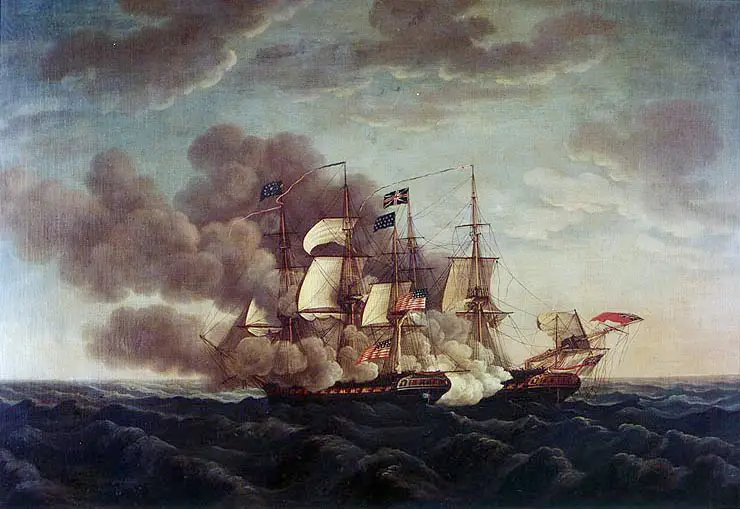
USS Constitution defeats HMS Guerriere, a significant event during the war. U.S. nautical victories boosted American morale (Wiki Image).
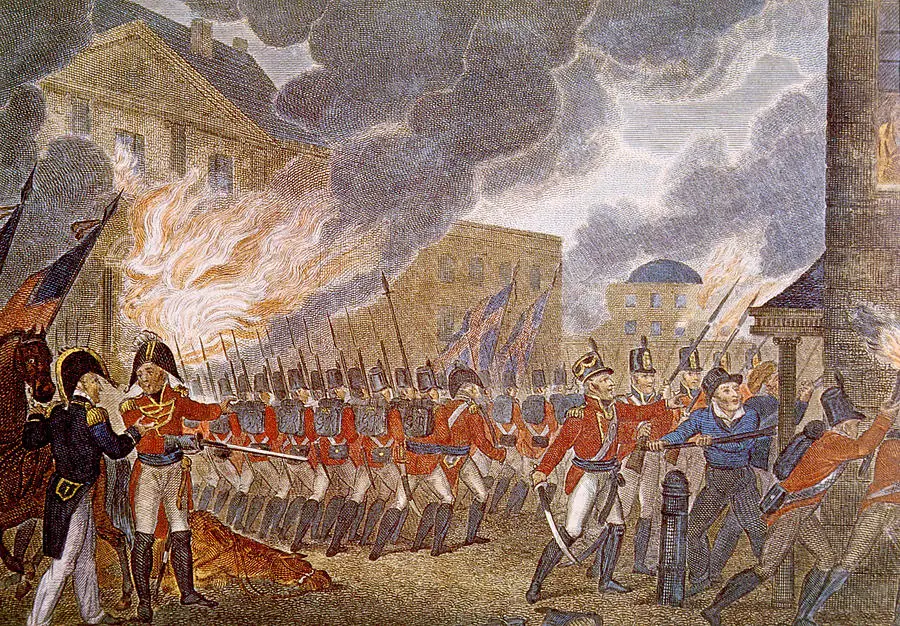
The British set ablaze the U.S. Capitol, among other buildings in the capital, while Madison was President on August 24, 1814 (Wiki Image).
- The War of 1812: Madison’s presidency is most notably marked by the War of 1812, often called the “Second War of Independence.” The war was primarily a response to British interference with American trade and impressment of American sailors, as well as British support for Native American attacks on American frontier settlements.
- Nationalism and Independence: The War of 1812 solidified American independence from Britain, as the conflict ended in a stalemate with the Treaty of Ghent (1814). Although there were no clear territorial gains, the war fostered a sense of American nationalism and unity. The successful defense against the British, including the burning of Washington, D.C., and the Battle of New Orleans, elevated Madison’s status and affirmed the United States’ sovereignty on the global stage.
- Economic Impact: The war also exposed the weaknesses of the U.S. economy and military infrastructure, leading to significant post-war reforms. Madison’s administration responded by supporting the creation of the Second Bank of the United States and advocating for improvements in national infrastructure.
- Foreign Relations: Madison’s foreign policy was dominated by tensions with both Britain and France as the U.S. attempted to navigate the Napoleonic Wars. His administration dealt with the challenges of maintaining neutrality while protecting American trade interests. The Non-Intercourse Act and Macon’s Bill No. 2 were efforts to pressure Britain and France to respect American neutrality, but they were only partially successful.
Domestic Policy Impact:
- Strengthening Federal Power: Despite being a staunch advocate of limited government, Madison’s presidency saw a strengthening of federal power in response to the challenges of the War of 1812. His support for the recharter of the national bank, tariffs, and infrastructure development marked a shift from his earlier strict constructionist views.
- Expansion and Infrastructure: Madison’s administration also laid the groundwork for America’s westward expansion. The war highlighted the need for better infrastructure, leading to post-war initiatives like constructing roads and canals, which would be central to the “American System” later promoted by Henry Clay.
Montpelier as a Symbol:
- Agrarian Values and Republicanism: Montpelier, Madison’s plantation in Virginia, is emblematic of his personal and political values. It reflects his commitment to republican ideals and the agrarian lifestyle that he and many of his contemporaries believed was essential to preserving liberty and democracy. Madison spent much of his life in Montpelier, including his years as a public servant and his retirement.
- Contradictions of Liberty: Like other Founding Fathers, Madison was a slave owner, and Montpelier was maintained by enslaved labor. This stark contradiction between Madison’s advocacy for individual rights and his ownership of slaves highlights the complex realities of the early American Republic and the deep-seated issue of slavery that would eventually lead to the Civil War.
- Legacy of Knowledge: Montpelier also symbolizes Madison’s intellectual legacy. Known as the “Father of the Constitution,” Madison spent much of his time at Montpelier studying, writing, and contemplating the principles of government. The estate represents his dedication to creating and preserving the American Republic.
Conclusion:
James Madison’s contributions to both foreign and domestic policy were profound. The Federalist Papers helped establish the theoretical foundation of the U.S. Constitution, while his leadership during the War of 1812 helped secure American independence and fostered a sense of national identity. Montpelier, his Virginia estate, symbolizes his agrarian values, intellectual pursuits, and the complex legacy of liberty and slavery in the early United States. Madison’s impact on American government and political thought remains profoundly influential today.
James Monroe: Highland
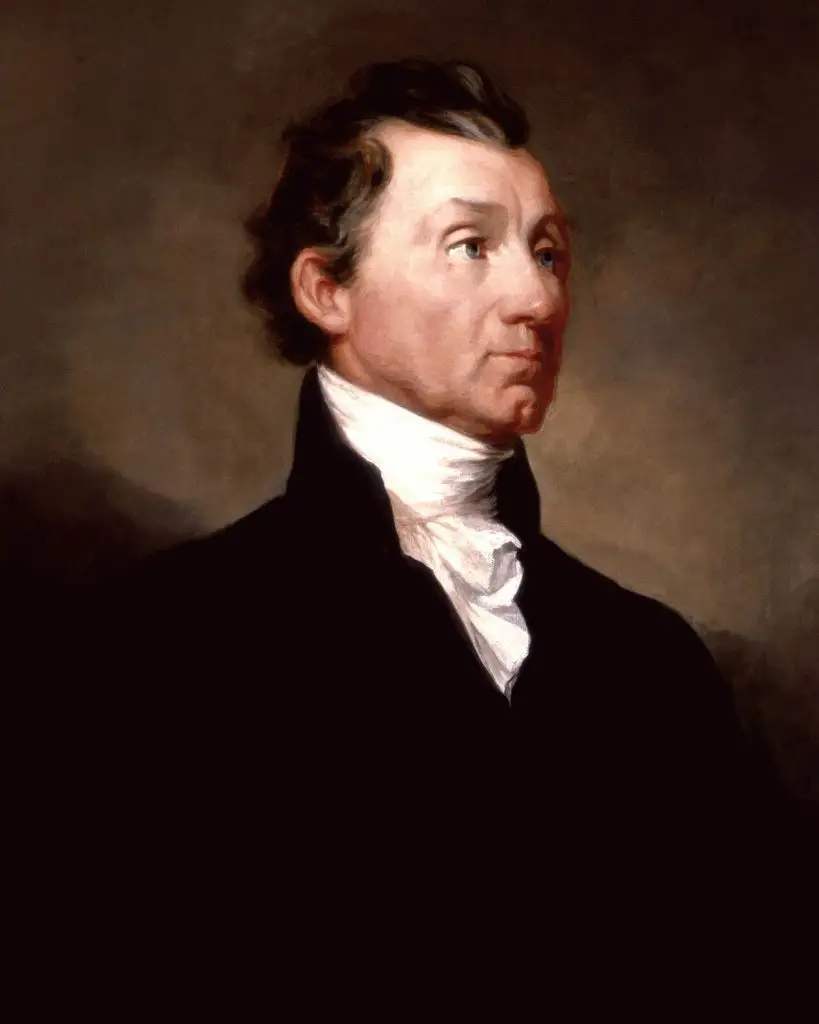
James Monroe (Wiki Image).
- James Monroe on Retirement to Highland:
- “It is my intention to retire to my farm at Highland, and there spend the remainder of my days.” — James Monroe
- James Monroe on Simplicity and Life at Highland:
- “I flatter myself that in returning to the walks of private life, I shall experience more real happiness than is to be found in the tumult of public employment.” — James Monroe, reflecting on his life at Highland
- James Monroe on Public Service:
- “National honor is national property of the highest value.” — James Monroe
- James Monroe on Leadership:
- “The best form of government is that which is most likely to prevent the greatest sum of evil.” — James Monroe
- James Monroe on the Monroe Doctrine:
- “In the discussions to which this interest has given rise, and in the arrangements by which they may terminate, the occasion has been judged proper for asserting, as a principle… that the American continents… are henceforth not to be considered as subjects for future colonization by any European powers.” — James Monroe, Monroe Doctrine
- James Monroe on Education:
- “A little flattery will support a man through great fatigue.” — James Monroe
- James Monroe on Liberty:
- “Our country may be likened to a new house. We lack many things, but we possess the most precious of all—liberty!” — James Monroe
- James Monroe on the Nation’s Future:
- “The American continents, by the free and independent condition which they have assumed and maintain, are henceforth not to be considered as subjects for future colonization by any European powers.” — James Monroe, Monroe Doctrine
- James Monroe on His Legacy:
- “It is only when the people become ignorant and corrupt, when they degenerate into a populace, that they are incapable of exercising their sovereignty.” — James Monroe
- James Monroe on Unity:
- “National honor is the national property of the highest value.” — James Monroe
| Year | Event/Development |
|---|---|
| 1730 | John Carter receives a 9,350-acre land grant, which includes the future Highland. |
| 1793 | James Monroe purchases 1,000 acres from Champe and Maria Carter, naming it Highland. |
| 1794 | Monroe departs for France to serve as Minister. Construction of the main house is delayed. |
| 1797 | Monroe returns from France and begins construction of the main house. |
| 1799 | The main house at Highland is completed. |
| 1799 | The Monroes move into Highland in November. |
| 1800 | Monroe describes Highland in an insurance policy as a ” wooden dwelling house, the Walls filled with Brick, one story high 40 feet long by 30 feet wide” with a one-story kitchen wing. |
| 1808 | Monroe’s daughter, Eliza, is married at Highland. |
| 1817 | Monroe is inaugurated as the fifth President of the United States. |
| 1818 | A two-room guesthouse with a lobby entrance is constructed to accommodate visitors. |
| 1826 | Monroe sells Highland due to financial difficulties. |
| 1831 | James Monroe dies in New York City. |
| 1974 | William & Mary, Monroe’s alma mater, acquires Highland. |
| 1980s – Present | Archaeological research and historical analysis reveal that the house traditionally considered Monroe’s main residence was the guesthouse. The original smaller house is discovered and interpreted. |
| 2000s – Present | Ongoing research and restoration efforts continue to uncover and interpret Highland’s history, including the lives of the enslaved people who lived and worked there. |
James Monroe’s Highland
(YouTube video)
HIGHLAND & MONROE HILL (James Monroe’s Charlottesville …
(YouTube video)
Location: Near Charlottesville, Virginia (called initially “Ash Lawn-Highland”)
Overview: Highland, the Virginia estate of James Monroe, the fifth President of the United States, is a significant historical site that reflects his personal life, political career, and contributions to American history.
Historical Significance
Early Ownership
- Acquisition: James Monroe purchased Highland in 1793 and used it as his primary residence until 1823. The estate is close to Monticello, the home of his close friend and mentor, Thomas Jefferson.
Political Career
- Home During Public Service: Highland served as Monroe’s residence during his extensive public service, including his terms as Secretary of State and Secretary of War under President James Madison and his two terms as President from 1817 to 1825.
- Presidential Retreat: Monroe used Highland as a retreat, entertaining guests and conducting business during his presidency.
Architecture and Design
Original House
- Modest Beginnings: The original house at Highland was relatively modest compared to the grand estates of Monticello and Montpelier. It was a one-and-a-half-story structure reflecting early American homes’ more straightforward, functional style.
- Expansion: Monroe expanded the house to accommodate his family and growing responsibilities. Additions included more living space and enhancements to the property’s functionality.
Notable Features
- Guest House: A small cottage on the property served as Monroe and his family’s temporary residence while the main house was being constructed.
- Outbuildings: Highland included several outbuildings necessary for plantation operations, such as slave quarters, a smokehouse, and a barn.
Life at Highland
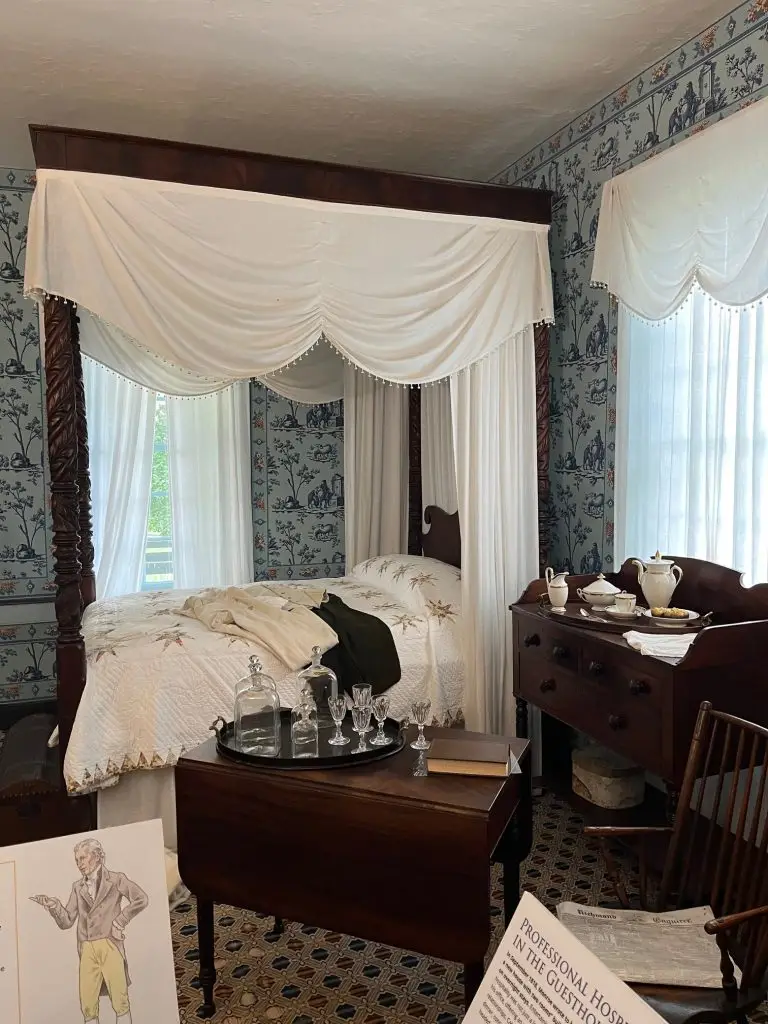
Bed (personal image).
Personal Life
- Family Home: Highland was home to Monroe, his wife Elizabeth Kortright Monroe, and their children. The estate was a center of family life and hospitality.
- Social Hub: Monroe entertained numerous guests, including political figures and foreign dignitaries, reflecting his prominent role in early American politics.
Agricultural Practices
- Working Plantation: Like many estates of the period, Highland was a working plantation. Monroe cultivated tobacco, wheat, and other crops, relying on the labor of enslaved African Americans.
- Innovative Farming: Monroe, influenced by his neighbor Jefferson, practiced innovative farming techniques to improve agricultural productivity and sustainability.
Legacy and Preservation
Historical Research and Archaeology
- Rediscovery: Recent archaeological research has led to the rediscovery and re-evaluation of the original structures on the estate. This research has provided new insights into Monroe’s life and the layout of Highland.
- Restoration Efforts: Efforts are ongoing to restore and preserve Highland, ensuring that it reflects the historical period accurately and educates the public about Monroe’s legacy.
Public Engagement
- Museum and Tours: Highland is now a museum open to the public. Visitors can tour the restored main house, guest house, and other parts of the estate to learn about Monroe’s life and times.
- Educational Programs: The site offers educational programs, including lectures, workshops, and special events, focusing on Monroe’s contributions to American history, the history of slavery, and early American agriculture.
Monroe’s Broader Legacy
The Monroe Doctrine
- Foreign Policy Impact: One of Monroe’s most enduring legacies is the Monroe Doctrine, articulated in 1823. This policy warned European powers against further colonization and interference in the Americas, shaping U.S. foreign policy for decades.
- Highland as a Symbol: Highland symbolizes Monroe’s presidency and his efforts to assert American independence and influence on the global stage.
Conclusion
Highland, James Monroe’s Virginia home, offers a unique glimpse into the life of the fifth President of the United States. The estate reflects Monroe’s personal and political life, his contributions to American history, and the complexities of early American society. Today, Highland serves as a historic site and educational center, preserving Monroe’s legacy and promoting an understanding of his role in shaping the nation.
Highlands
James Monroe Highlands Acquisition, Home During Public Service, and Presidential Retreat.
Certainly! Here’s a look at James Monroe’s Highland through its various roles, with visuals to enhance your understanding.
Acquisition
In 1793, James Monroe acquired the Highland estate in the scenic countryside of Charlottesville, Virginia. This property held special significance for Monroe due to its proximity to Monticello, the home of his close friend and mentor, Thomas Jefferson. The estates’ closeness fostered a deep bond and frequent interaction between the two statesmen.
Home During Public Service:
Highland served as Monroe’s primary residence throughout his illustrious public service career. He lived there while holding key positions in the federal government, including Secretary of State and Secretary of War under President James Madison. Remarkably, even during his two terms as President of the United States, from 1817 to 1825, Highland remained his beloved home.
Presidential Retreat:
Beyond its function as a residence, Highland played a crucial role as Monroe’s presidential retreat. He frequently entertained guests and conducted official business at the estate, enjoying its tranquil atmosphere and convenient access to Monticello. The estate offered him respite from the demands of Washington, D.C., while allowing him to remain connected to the political arena.
Therefore, Highland was more than just a house for James Monroe. It was a place of solace, a hub for political activity, and a symbol of his enduring friendship with Thomas Jefferson. Its location and Monroe’s consistent use throughout his presidency underscore its significance in American history.
James Monroe Highlands Modest Beginnings, Expansion, Guest House, and Outbuildings.
Modest Beginnings
When James Monroe first acquired Highland in 1793, the house was relatively small and unassuming, reflecting the practical and functional style typical in early American homes. This initial building starkly contrasted the grandeur and opulence of neighboring estates like Monticello and Montpelier. It was a one-and-a-half-story house, likely built with local materials and designed for simple living.
Expansion
As Monroe’s family grew and his responsibilities increased, so did the need for a larger, more accommodating home. Over time, he expanded Highland significantly, adding wings and rooms to the main house. The expansions aimed to create a more comfortable living space for his family and to provide areas for entertaining guests and conducting official business. While specific details of these expansions are not fully documented, it’s clear that they transformed Highland into a more substantial and impressive dwelling.
Guest House
During the construction and expansion of the main house, a small cottage on the property served as a temporary residence for Monroe and his family. This guest house provided a place to stay while the main house underwent renovations and additions. It also likely served as accommodation for visitors to the estate.
Outbuildings
Like many estates of the time, Highland featured a collection of outbuildings essential to its operation as a working plantation. These structures included:
- Slave Quarters: These buildings housed the enslaved people who labored on the plantation, a stark reminder of the harsh reality of slavery in early America.
- Smokehouse: A smokehouse was used to cure and preserve meats, ensuring food supply throughout the year.
- Barn: The barn was a vital storage space for crops, livestock, and agricultural equipment.
These outbuildings, along with the main house and guest house, formed a complex that supported both the Monroe family’s domestic and agricultural needs and the Highland enslaved community.
Highland’s evolution from a modest dwelling to a presidential estate reflects Monroe’s journey and the changing needs of his family and public life. While it may not have achieved the grandeur of some neighboring estates, Highland holds significant historical value as a testament to the life and times of James Monroe, the fifth President of the United States.
James Monroe Highlands Family Home, Social Hub, Working Plantation, and Innovative Farming.
James Monroe’s Highland served as much more than just a residence for the Monroe family; it was a social hub, a working plantation, and a site of agricultural innovation. Monroe’s approach to managing Highland reflected his commitment to public service and private enterprise, and the estate played a significant role in his personal and political life.
Family Home
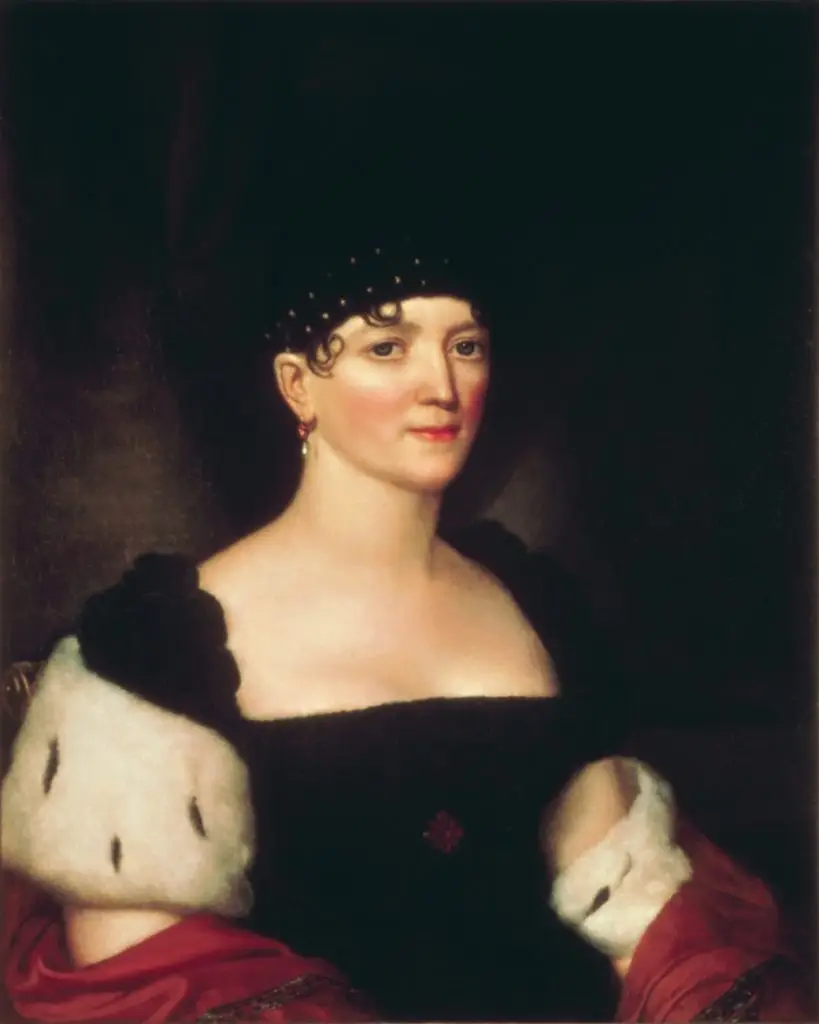 Elizabeth Kortright (Wiki image).
Elizabeth Kortright (Wiki image).
- Primary Residence: Highland was the Monroe family’s primary residence for many years, particularly during the periods when Monroe was not serving abroad or in Washington, D.C. James Monroe lived there with his wife, Elizabeth Kortright Monroe, and their children, making it the center of their family life. The home was relatively modest compared to other estates of the period, but it provided a comfortable and practical living space.
- Personal Life: Despite his extensive public duties, Monroe valued his time at Highland, where he could be with his family and manage the day-to-day affairs of his estate. The Monroes’ time at Highland allowed them to maintain a close-knit family environment, and the estate served as a retreat from the pressures of public life.
Social Hub
- Entertaining Guests: Highland was a lively social hub, particularly during Monroe’s presidency and his time as Secretary of State. The Monroes hosted many prominent guests at the estate, including political allies, foreign dignitaries, and neighbors like Thomas Jefferson. The guest house and main residence were often filled with visitors who came to discuss politics, enjoy the Monroes’ hospitality, or simply experience the beauty of the Virginia countryside.
- Political and Social Gatherings: The estate was a venue for important political and social gatherings, where ideas were exchanged and relationships were forged. These gatherings were social events and opportunities for Monroe to discuss and refine his political ideas with trusted friends and colleagues. Highland’s role as a social hub helped Monroe maintain and build the networks crucial to his political career.
Working Plantation
- Agricultural Operations: Highland was a working plantation primarily cultivating cash crops such as tobacco and wheat. Monroe, like many of his contemporaries, relied on the labor of enslaved people to manage and operate the plantation. The estate’s economy was built on producing and selling these crops, which were critical to sustaining Monroe’s financial stability and supporting his public service.
- Plantation Management: Monroe took an active role in managing Highland, particularly in overseeing the agricultural operations. Despite his frequent absences due to public duties, Monroe was involved in decisions about crop rotation, land use, and the overall management of the estate. He aimed to make Highland a profitable and sustainable enterprise, though he often faced financial difficulties exacerbated by the costs associated with his public service and the estate’s maintenance.
- Role of Enslaved Labor: Highland’s success as a working plantation depended on the labor of the enslaved individuals who lived and worked there. These men, women, and children performed various tasks, from fieldwork to skilled labor in the estate’s outbuildings. The reliance on enslaved labor is a critical aspect of Highland’s history, reflecting the broader economic and social realities of the time.
Innovative Farming
- Agricultural Experimentation: James Monroe was interested in farm innovation and implemented several practices at Highland aimed at improving productivity and sustainability. He experimented with crop rotation, soil improvement techniques, and fertilizers, reflecting the growing movement among Virginia planters to adopt more scientific approaches to farming.
- Diversification: Monroe also sought to diversify the crops grown at Highland, moving beyond the traditional reliance on tobacco, which was hard on the soil. He cultivated wheat, corn, and other crops and experimented with different planting methods to enhance yields and maintain the fertility of the land.
- Influence of Neighbors: Monroe’s approach to farming was influenced by his close relationships with other prominent Virginians, including Thomas Jefferson, who was also interested in agricultural innovation. The exchange of ideas between Monroe and his peers contributed to adopting more advanced farming techniques at Highland.
Highland remains a significant historical site, offering a rich and complex portrait of James Monroe’s life and legacy. It is a testament to his efforts to balance public service with personal responsibilities and his commitment to innovation and progress in politics and agriculture.
James Monroe Highlands Paintings, Furniture, and Sculpture.
While there are not many surviving paintings or sculptures directly associated with James Monroe’s Highland Plantation, there are a few notable pieces and some interesting historical connections that shed light on the estate’s artistic and cultural aspects.
Paintings
-
- Portraits of James Monroe: Although not specifically painted at Highland, portraits of James Monroe, such as those by Gilbert Stuart and Rembrandt Peale, offer a glimpse into the man who called Highland home.
-
- Depictions of Highland: A painting by George Cooke from 1822 shows the main house and surrounding landscape, offering a visual representation of the estate during Monroe’s time.
Furniture
-
- Original Pieces: Some original furniture pieces from Monroe’s time remain at Highland, including a high-post bed and a chest of drawers, showcasing the style and craftsmanship of the early 19th century.
- Period Reproductions: To complement the original furnishings, Highland also features carefully selected period reproductions that help recreate the ambiance of Monroe’s era.
Sculpture
-
- Bust of James Monroe: A bust of James Monroe, crafted by an unknown artist, is displayed at Highland, serving as a reminder of the former president’s presence.
Although the artistic collection directly related to Highland may be limited, the existing pieces, combined with the historic architecture and landscape, offer a valuable insight into the life and times of James Monroe and his family at their beloved estate.
James Monroe Highlands Rediscovery, Restoration Efforts, Museum and Tours, and Educational Programs.
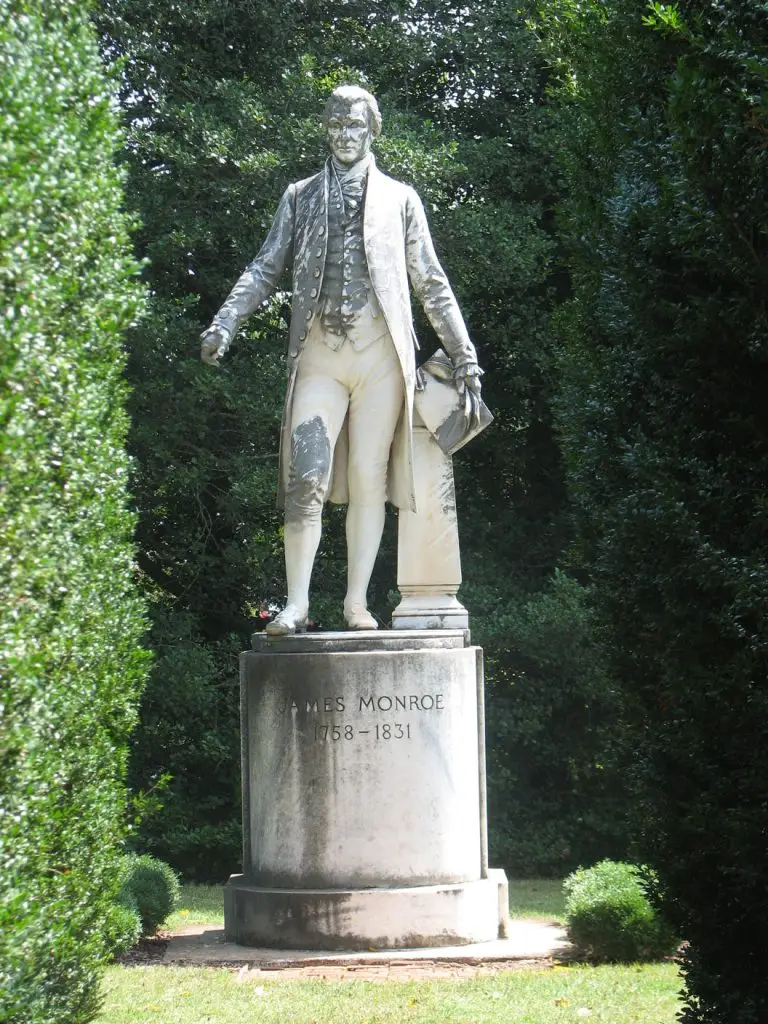
Statue of Monroe at Highland, his house near Charlottesville, Virginia (Wiki Image).
James Monroe’s Highland has undergone a significant transformation from a private residence to a historical site that educates the public about Monroe’s life, the early American republic, and the complex history of plantation life. Here’s an overview of the rediscovery restoration efforts, the museum and tours, and the educational programs at Highland.
Rediscovery
- Archaeological Discoveries: For many years, the structure believed to be Monroe’s main house at Highland was a guest house. The rediscovery began with archaeological investigations in the early 21st century that uncovered the foundations of the original main house, which had been lost to history after Monroe’s time. This discovery corrected long-held assumptions about the estate’s layout and clarified Monroe’s living arrangements.
- Reinterpreting the Site: The findings led to reevaluating the historical narrative presented at Highland. The rediscovery of the main house’s remains allowed historians and archaeologists to understand better the estate’s original appearance and the daily life of its inhabitants. This has resulted in a more accurate and complete interpretation of Monroe’s time at Highland.
Restoration Efforts
- Restoration of Buildings: Following rediscovering the original main house, efforts were made to restore and preserve the existing structures at Highland, including the guest house, outbuildings, and landscape. The restoration focused on maintaining the site’s historical integrity while accurately reflecting Monroe’s residence period.
- Historical Accuracy: The restoration efforts have been guided by extensive research, including the use of historical documents, architectural studies, and archaeological evidence. The goal has been to create a site as close as possible to how it would have appeared during Monroe’s time while also accommodating the needs of a modern historic site.
- Preserving the Landscape: The surrounding landscape and buildings have been essential to the restoration. This includes the gardens, pathways, and agricultural fields, carefully managed to reflect their historical use. The landscape restoration helps visitors understand the estate as a working plantation and a family home.
Museum and Tours
- Highland as a Museum: Today, Highland operates as a museum dedicated to James Monroe’s life and legacy. The museum includes the guest house, which has been restored and furnished to reflect the period of Monroe’s residence. The house contains exhibits on Monroe’s life, his presidency, and his contributions to American history.
- Guided Tours: Visitors to Highland can take guided tours that offer insights into Monroe’s life, the history of the estate, and the broader context of the early American republic. These tours often include discussions of Monroe’s political career, his role in shaping the nation, and the daily operations of the plantation.
- Exhibits on Enslavement: The museum focuses mainly on the lives of the enslaved people who lived and worked at Highland. Exhibits and tours provide information about their contributions to the estate, living conditions, and struggles. This aspect of the museum seeks to provide a more complete and honest portrayal of Highland’s history.
Educational Programs
- Public Education: Highland offers a range of educational programs designed to engage visitors of all ages with the history of James Monroe, the Constitution, and the complexities of plantation life. These programs include lectures, workshops, and hands-on activities that explore various aspects of American history.
- School Programs: The estate provides educational programs for school groups, focusing on the early American republic, Monroe’s role in American history, and the experiences of the people who lived and worked at Highland. These programs are designed to align with educational standards and give students a deeper understanding of the period.
- Special Events and Symposiums: Highland also hosts special events and symposiums that bring together scholars, historians, and the public to discuss historical topics related to Monroe and his time. These events often focus on themes such as constitutional history, diplomacy, and the legacy of slavery.
- Interactive Exhibits and Programs: The museum offers interactive exhibits that allow visitors to engage more deeply with Highland’s history and James Monroe’s life. These exhibits might include digital displays, reenactments, or other hands-on activities that make history come alive for visitors.
Commitment to Inclusivity and Dialogue
- Engaging Descendant Communities: Highland has made a concerted effort to engage with the descendant communities of the enslaved individuals who lived and worked on the estate. This includes collaborative projects, oral history initiatives, and partnerships to preserve and interpret the history of slavery and its legacy at Highland.
- Ongoing Research and Interpretation: The site continues to evolve as ongoing research uncovers new information about the estate’s history. This research informs the interpretation and educational programs, ensuring that Highland remains a dynamic and relevant historical site.
Through its restoration efforts, museum exhibits, tours, and educational programs, James Monroe’s Highland offers a rich and nuanced understanding of the early American Republic, the complexities of plantation life, and the legacy of one of the nation’s Founding Fathers. The site serves as both a place of learning and reflection, helping visitors connect with the past meaningfully.
Monroe’s Foreign and Domestic Policy Impact, The Monroe Doctrine, and Highland as a Symbol.
James Monroe, the fifth President of the United States, significantly impacted foreign and domestic policy during his presidency (1817-1825). His most notable contribution to foreign policy is the Monroe Doctrine, which has had a lasting influence on U.S. relations with the rest of the world, particularly in the Western Hemisphere.
Monroe’s Foreign Policy Impact:
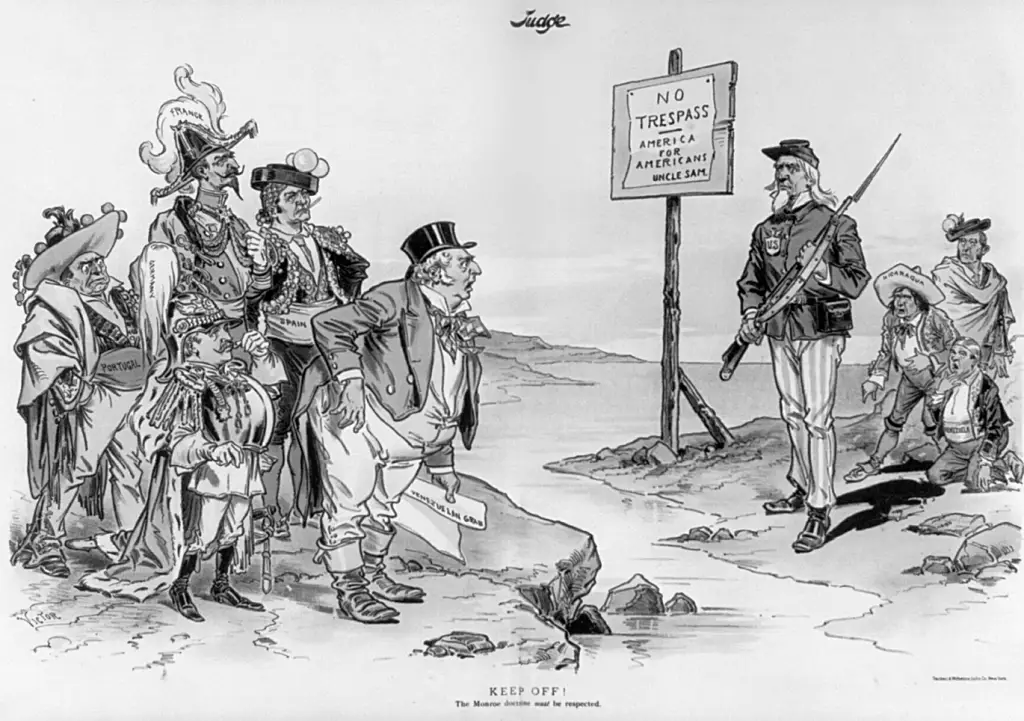
Gillam‘s 1896 political cartoon, Uncle Sam, stands with a rifle between the Europeans and Latin Americans (Wiki Image).
- The Monroe Doctrine (1823): The Monroe Doctrine is Monroe’s most famous foreign policy initiative. It was articulated in his seventh annual message to Congress on December 2, 1823. The doctrine declared that the Western Hemisphere was closed to further European colonization and that any attempt by European powers to interfere in the Americas would be considered an act of aggression, requiring U.S. intervention. In exchange, the United States pledged not to interfere in the internal affairs of European countries or their existing colonies.
- Long-term Impact: The Monroe Doctrine established the United States as the dominant power in the Western Hemisphere, laying the groundwork for future U.S. expansion and influence in the region. Later, presidents invoked it in various forms to justify U.S. intervention in Latin America and the Caribbean, and it became a cornerstone of U.S. foreign policy.
- Relations with Europe: During Monroe’s presidency, he successfully navigated relations with European powers, ensuring the United States remained neutral in European conflicts while asserting its interests in the Americas. The Monroe Doctrine was partly a response to concerns that European powers, notably the Holy Alliance of Russia, Austria, and Prussia, might try to restore Spain’s former colonies in Latin America to colonial rule.
Monroe’s Domestic Policy Impact:
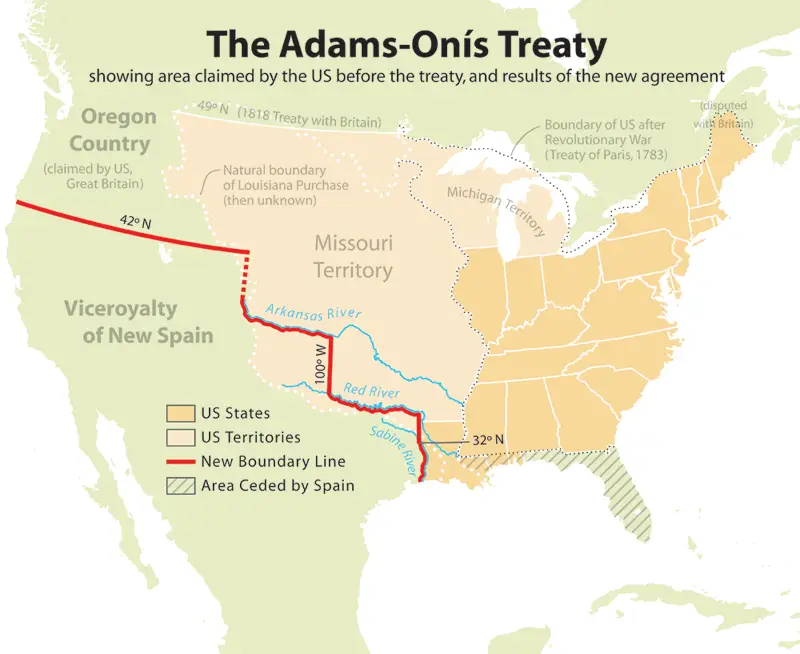
Map showing the results of the Adams–Onís Treaty of 1819 (Wiki Image).
- The Era of Good Feelings: Monroe’s presidency is often associated with the “Era of Good Feelings,” a period marked by national unity and a decline in partisan politics following the War of 1812. Monroe’s domestic policy focused on national growth and infrastructure development, including support for the American System, which aimed to strengthen the economy through protective tariffs, a national bank, and internal improvements like roads and canals.
- Westward Expansion: Monroe continued the policy of westward expansion initiated by his predecessors. Under his administration, the United States acquired Florida from Spain through the Adams-Onís Treaty of 1819. This treaty also defined the boundary between the U.S. and Spanish territories in the West, furthering U.S. territorial expansion.
- Missouri Compromise (1820): The Missouri Compromise, passed during Monroe’s presidency, was a significant domestic policy that addressed the growing tensions between free and slave states. The compromise allowed Missouri to enter the Union as a slave state and Maine as a free state, maintaining the balance of power in Congress. It also prohibited slavery north of the 36°30′ parallel in the Louisiana Territory. Although it temporarily eased sectional tensions, it foreshadowed the conflicts that would eventually lead to the Civil War.
Highland as a Symbol:
Highland was James Monroe’s plantation home in Virginia, and like Jefferson’s Monticello, it symbolizes his legacy. Highland represents several aspects of Monroe’s life and presidency:
- Agrarian Values: Highland reflects Monroe’s commitment to the agrarian lifestyle, which was central to the vision of early American leaders. Like many of his contemporaries, Monroe believed the nation’s strength lay in its independent, land-owning farmers.
- Contradictions of Liberty: Highland also symbolizes the contradictions in Monroe’s life, much like Monticello does for Jefferson. Despite being a proponent of liberty and republican values, Monroe, like many of his peers, was a slave owner. This underscores the moral complexities of the Founding Fathers and the deep-rooted institution of slavery in American society.
- Legacy and National Unity: As a symbol, Highland represents Monroe’s role in fostering national unity and his contributions to the expansion and security of the United States. The Monroe Doctrine, crafted at Highland, reflects his vision of an independent and sovereign American continent free from European domination.
Conclusion:
James Monroe’s presidency left a lasting mark on U.S. foreign and domestic policy. The Monroe Doctrine established a long-standing principle of American foreign policy, asserting U.S. dominance in the Western Hemisphere. Domestically, Monroe’s policies contributed to national unity and territorial expansion, though they also highlighted the ongoing tensions surrounding slavery. As a symbol, Highland encapsulates Monroe’s vision for the country and the contradictions that characterized the early republic.
Similarities Between the Homes of Thomas Jefferson, James Madison, and James Monroe
- Location in Virginia: All three homes—Monticello, Montpelier, and Highland—are located in Virginia, highlighting the state’s historical significance and its role in the lives of these early American presidents.
- Presidential Retreats: Each estate served as a personal retreat for its owner during their respective presidencies. These homes were places where they could escape the pressures of political life, engage in personal and intellectual pursuits, and manage their agricultural interests.
- Agricultural Estates: Monticello, Montpelier, and Highland were all working plantations that relied on enslaved labor. The owners were deeply involved in farming practices and innovations, reflecting the agrarian economy of the time.
- Historical Preservation: Today, each home has been preserved as a museum open to the public. These sites offer educational programs and tours that provide insights into the lives, contributions, and legacies of Jefferson, Madison, and Monroe.
- Influence of Thomas Jefferson: Both James Madison and James Monroe were influenced by Thomas Jefferson, particularly regarding agricultural practices and political philosophy. This influence is evident in the similarities in their estates’ operations and their engagement in intellectual activities.
Differences Between the Homes of Thomas Jefferson, James Madison, and James Monroe
- Architectural Style and Design:
- Monticello: Designed by Jefferson himself, Monticello is a neoclassical masterpiece with innovative features such as a dome, skylights, and a revolving bookstand. It reflects Jefferson’s architectural ingenuity and personal tastes.
- Montpelier: Initially a Georgian structure, Madison expanded it to include Federal-style elements. Notable features include the Temple, a small classical-style building used as a study, and a formal garden.
- Highland: More modest and functional than Monticello and Montpelier, Highland was practical and suited Monroe’s needs. It was later expanded but remained more straightforward in design.
- Scope of Influence:
- Monticello: Known for its architectural innovation and Jefferson’s intellectual pursuits. It served as a center for scientific and philosophical discussions.
- Montpelier: Significant for Madison’s role in drafting the Constitution and his intellectual activities. It was a place where Madison prepared for the Constitutional Convention and engaged with fellow thinkers.
- Highland: Associated with Monroe’s presidency and the Monroe Doctrine. Highland was less known for architectural significance but played a key role during Monroe’s political career.
- Gardens and Grounds:
- Monticello: Featured extensive and meticulously designed gardens, orchards, and vineyards, reflecting Jefferson’s interest in horticulture and landscape design.
- Montpelier: Included a formal garden designed by Madison, mirrored the period’s landscaping trends.
- Highland: Focused on practical agriculture with various crops. Monroe’s approach was influenced by Jefferson’s farming techniques but emphasized practicality.
- Historical Use:
- Monticello: Jefferson’s design reflected his interests, serving as a center for his scientific experiments and intellectual activities and as a family home.
- Montpelier: Madison used Montpelier as a place to prepare for the Constitutional Convention and as an intellectual hub, engaging in extensive correspondence and discussions on political theory.
- Highland: Served as Monroe’s home during significant political roles, including his presidency. It was a functional estate where Monroe conducted political and social activities.
- Legacy and Preservation Efforts:
- Monticello: A UNESCO World Heritage Site, Monticello is extensively preserved and offers numerous educational programs, reflecting Jefferson’s lasting legacy.
- Montpelier: Restored to its 19th-century appearance, Montpelier serves as a museum and educational center, focusing on Madison’s contributions to the Constitution and American governance.
- Highland: Ongoing archaeological research and restoration efforts aim to provide a deeper understanding of Monroe’s life. Highland is focused on historical accuracy and public education, emphasizing Monroe’s legacy and the complexities of early American history.
Comparison of Homes: Thomas Jefferson, James Madison, and James Monroe
| Feature | Thomas Jefferson: Monticello | James Madison: Montpelier | James Monroe: Highland |
| Location | Charlottesville, Virginia | Orange County, Virginia | Near Charlottesville, Virginia |
| Architectural Style | Neoclassical with innovative features | Georgian and Federal styles | Early American, functional and modest |
| Construction Period | Began in 1768 and continued until Jefferson’s death | Original house built in 1760s; expanded early 1800s | Purchased in 1793, expanded during Monroe’s residence |
| Notable Architectural Features | Dome, skylights, revolving bookstand, dumbwaiter | Temple (study), formal garden | Small cottage (guest house), outbuildings |
| Gardens and Grounds | Extensive gardens, orchards, and vineyards | Designed garden reflecting period trends | Working on a plantation with various crops |
| Agricultural Practices | Experimental farming techniques | Scientific farming, crop rotation | Innovative farming influenced by Jefferson |
| Primary Use | Personal retreat, scholarly pursuits, family home | Political retreat, family home | Presidential retreat, family home |
| Historical Significance | Jefferson’s design, intellectual activities | Madison’s Constitution preparation, intellectual hub | Monroe’s residence during political career |
| Slavery | Enslaved labor on the plantation | Over 100 enslaved individuals | Enslaved African Americans |
| Legacy and Preservation | UNESCO World Heritage Site, museum, educational programs | Restored to 19th-century appearance, the museum | Archaeological research, ongoing restoration |
| Current Status | The museum is open to the public and operated by the Thomas Jefferson Foundation. | Museum and educational center | The museum is open to the public and operated by James Monroe’s Highland Foundation |
| Significant Contributions | Political and architectural innovations | “Father of the Constitution,” political thought | Monroe Doctrine, foreign policy impact |
Summary
- Thomas Jefferson’s Monticello: Known for its neoclassical design and innovative features, Monticello reflects Jefferson’s architectural creativity and intellectual pursuits. The estate symbolizes Jefferson’s contributions to American history and is a UNESCO World Heritage Site.
- James Madison’s Montpelier: A Georgian and Federal-style mansion, Montpelier was the home of the “Father of the Constitution.” The estate is notable for Madison’s intellectual activities and scientific farming practices. It is now a museum and educational center.
- James Monroe’s Highland: A more modest and functional estate than Monticello and Montpelier, Highland was Monroe’s residence during his significant political career. The site is undergoing restoration and archaeological research to better understand Monroe’s life and contributions.

